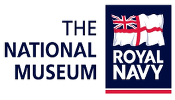INTRODUCTION
NEVER in the history of the world
has sea power played so vital a part in the winning
of a war; and never, in proportion to the magnitude
of the forces and operations involved, has the Navy
played a part in which its proverbial silence has
been as marked as in the activities which terminated
on November 11, 1918, with the armistice between the
Allied and the Central Powers.
The war in its naval aspects, has
been a war of negative action; a series of
checkmates, by which the Allied navies secured the
seas from the interference of the grand fleets and
raiding squadrons of the enemy. But in this war the
submarine, a new weapon of offensive warfare,
imposed new conditions. Relatively secure in its
operations from the larger vessels of the Allied
navies, which themselves were in many instances its
ready prey, the submarine directed its activities
against the troop and store ships by which alone the
men and means to prosecute the war were made
possible.
To meet the preying warfare of the
submarine, the smaller and faster vessels of our
Navy were required in European waters, to assure the
safe and uninterrupted passage of our “bridge of
ships." It is not the purpose of this narrative to
deal with the operations of the United States Naval
Forces in English waters or in the Mediterranean. In
the north, the concerted action with the British
Navy, and in the south the cooperation with the
navies of France and Italy developed operations of
which it is impossible at this early date to secure
even casual data.
Of the activities of the United
States Naval Forces in France, it is possible,
however, to obtain more definite information, due
primarily to the fact that these operations were
more sharply defined and more distinctly our own. To
keep open the western coast of France was a task of
the most vital importance, involving a large and
capable organization and the utmost secrecy of
operation.
Due to this necessity for secrecy,
little has been known of the work of our Navy on the
French coast. To the majority of the American people
our men and stores have been transported with a
miraculous freedom from disaster, but the means by
which this security has been attained have been
unknown.
In no sense is this volume offered
as a history of the United States Naval Forces in
France, for a historic record of those splendid
activities would require a study of the complete
operations which is at the present time impossible.
Rather, it is the present purpose to afford, by a
few side lights on these activities of sixteen
months, a general view of the field and an
impression of the nature of the work involved. By
these, our most recent operations in the world's
most historic waters, the forces of the Navy not
only secured the desired safe passage of our troop
and store ships but by their cooperation with the
French Naval Forces and their association with the
people of the French nation, on land as on the sea,
established a sentiment of mutual affection and
esteem more permanent than can be obtained by
treaties or the written word.
More than the United States can
ever realize, does it owe to those who directed our
naval operations in French waters, a gratitude for
past performance and for future promise.
Brest,
France, December 2, 1918.
PREFACE
By
Franklin D. Roosevelt
Assistant
Secretary
of the Navy
THE Navy was known during the war
as the "Silent Service." Little appeared in official
dispatches or in the public press regarding the
operations of the United States Naval Forces either
in Europe or on our own coast. In fact, in only a
handful of instances, where a transport was
torpedoed or where an enemy submarine was definitely
accounted for, was any mention made of our naval
work. Generally speaking, the people at home knew
only that their Navy was successfully manning the
transports and escorting the troops, munitions, and
supplies in safety to the shores of France.
How very much more these operations
involved is only now coming out. On our entrance
into the Great War in the spring of 1917, steps were
immediately taken by the Navy Department to build up
an organization to be based on the French coast,
primarily for the purpose of keeping the famous
"Neck of the Bottle" as free as possible from German
submarines. The distance from Bordeaux to Brest is a
comparatively small one, and almost every ship
entering the French ports from the United States
had, of necessity, to pass through a narrow strip of
sea. This small area had proved a famous hunting
ground for enemy submarines, and it became our
obvious task to send over every possible means of
assistance to work with the French Navy.
The story of what our officers and
men did in those early days is the best illustration
of the all-round efficiency of the Navy. A large
proportion of the officers and men came from civil
life, but were quickly and successfully
indoctrinated into their naval duties by the regular
officers of the service. The tools with which they
had to work were, in large part, makeshift. Yachts
were hurriedly converted to naval purposes; all
kinds of equipment was taken over for possible use
in France. From small beginnings the organization
grew until by the summer of 1918 the whole western
coast of France was guarded by a string of surface
vessels and aircraft.
Not only was the ''Neck of the
Bottle" made safe for our troop and supply ships,
but the operations were extended from the defensive
type to the offensive, and the very existence of
enemy submarines was rendered extremely unhealthy
long before the armistice came.
To the men who took part in this
great work too much credit cannot be given.
Extraordinary physical endurance was called for, and
more than that, imagination and a genius to meet new
conditions with untried weapons was essential to
success.
During the summer of 1918 I had the
pleasure of visiting these French bases and of
seeing the work at first hand. No part of our naval
activities deserves higher credit than the part they
took. They have the satisfaction, at least, of
knowing that the Navy and the country are proud of
them.
Washington,
D. C, April 25, 1919
CHAPTER
I
FIRST
MONTHS OF THE WAR
WITH the entry of the United States
into the war with Germany and the Central Powers,
arose the immediate necessity of naval participation
and cooperation with the fleets of the Allied
nations. Never in the world's history had been
furnished an example so complete and so convincing
of the vital necessity of adequate sea power to
secure the desired victory over the common foe. For
three years the great fleets of England had been
holding in leash the German Navy, but despite the
assurance which England's fleet had given for the
protection of the seas from the German High Sea
Fleet, other grave dangers were clearly existent. In
the Channel, on the west coast of Ireland, along the
French coast and in the Mediterranean, the German
and Austrian submarines were waging a successful
warfare against the Allied shipping. To hold in port
the powerful Navy of Germany, the Grand Fleet of
England was chained to its guardianship of the
Helgoland gates, and on a similar duty the French
fleet watched the harbors and naval bases of Austria
in the Mediterranean.
The entry of the United States into
the war, created new problems which it alone must
solve; problems of transportation of troops and
supplies to the practically unprotected ports of
western France.
Tied hand and foot were the fleets
of the Allies. Not only did it devolve upon us to
deliver an army on French soil and the necessary
stores required by these hundreds of thousands of
fighting men; but it also became necessary for us in
large measure, to protect the passage and arrival of
the vessels required for troop and store transports.
From Calais the French coast slips
in a south-westerly direction, embracing in its
rugged coast line the ports of Boulogne, Le Havre
and Cherbourg, to the rocky point of Finisterre
where in a great sheltered harbor, at its western
extremity, rests the city of Brest, greatest of all
French seaports from the aspects of naval strategy.
From Brest, the coast runs southeasterly to the
Spanish line, including, from north to south, the
harbors of Lorient, Quiberon Bay, Saint-Nazaire, La
Rochelle, Rochefort, the Gironde River and Bordeaux,
the Adour River and Bayonne and the little southern
fishing port of Saint-Jean de Luz almost in the
shadow of the Pyrenees. Of these ports, Brest,
Lorient, Saint-Nazaire and the Gironde offered the
best facilities for the reception of troops and
stores; and it was here that the preliminary steps
were taken to prepare for their arrival. But the
great work of the Navy was apparently to be not on
French soil or on the wide Atlantic, but
particularly in the submarine danger zone which
naturally centered at those points on the French
coast where the greatest number of transatlantic
lanes converged; in other words, in the Bay of
Biscay at Brest, and in the Channel.
To understand more clearly the
nature of the convoy work, it may be divided into
two general classes:
First, the escorting into and out
of port through the danger zone of the
transatlantic convoys; and, second, the escorting
of the coastal convoys from port to port. The
mission of the United States Naval Forces in
France may thus be crystallized into the following
sentence: “To safeguard United States troop and
store ships and to cooperate with the French naval
authorities."
Granted, therefore, the hypothesis
that with a limited number of ports of arrival in
France the enemy submarines would have only to watch
the immediate approaches to these ports, the problem
became simplified and the work resolved itself into
a system of convoys, both coastal and deep sea, so
thorough in its character, that the submarines would
be forced from the entrances of the harbors and be
compelled to wait for the convoys at a considerable
distance off the coast and in the open sea where the
chance of meeting was materially reduced and where
the attendant dangers and hardships were greatly
increased.
On the entire western coast of
France and in the Channel, German submarines were
particularly active; it was but logical to calculate
that this activity would increase as the volume of
American shipping was augmented. To meet this
submarine blockade and carry against it a successful
warfare, was especially required a type of small and
swift vessels capable of mounting guns of
intermediate caliber and of being rapidly maneuvered
and, at the same time, possessing sufficient
seaworthy qualities to withstand the strains of
continuous service in waters notoriously
tempestuous. For this work the destroyer was
unquestionably the ideal type, but as the few
destroyers available had been sent to English
waters, the yachts were taken over and converted as
far as possible to meet the requirements. Later, by
the addition of a number of destroyers, it was
planned to provide a force of sufficient strength
and mobility to offset the submarine activities and
assure the safety required to place our troops and
stores on French soil. To cooperate with the United
States' Naval Forces, the French Navy afforded a
number of small destroyers and fast patrol boats,
suitably armed and familiar with the waters in which
the major operations would necessarily take place.
In addition, the French naval establishment
possessed adequate and most excellent mine-sweeping
facilities and also a limited force of hydroplanes
and dirigibles for cooperation with the patrol and
escort vessels.
It is appropriate to recall at the
beginning of this narrative of our latest naval
achievements that it was in these same historic
French waters, that our Navy found its birth, and
that in Quiberon Bay the Stars and Stripes, flying
from the U. S. S. Ranger of John Paul Jones,
received its first salute from a foreign nation when
the guns of the fleet of the French Admiral le
Motte, thundered a welcome to this new-born ensign
of the new-born nation across the sea.
On June 4, 1917, a small fleet of
six yachts left the New York Navy Yard and steamed
slowly down the stream. This force, a handful of
converted pleasure vessels, bore the official
designation of the U. S. Patrol Squadrons Operating
in European Waters and constituted the first
American naval participation in the Great War,
actually to be established in French waters. The
yachts were:
U. S. S. Kanawha
U. S. S. Vedette
U. S. S. Noma
U. S. S. Christabel
U. S. S. Harvard
U. S. S. Sultana
and also included in this force,
but temporarily under the orders of Rear-Admiral
Gleaves, were the U. S. S. Corsair and the U. S. S.
Aphrodite.
| |
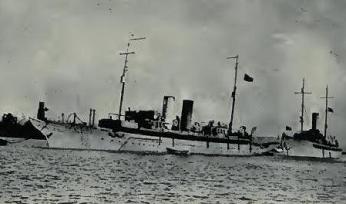
U. S. S. Noma
|
|
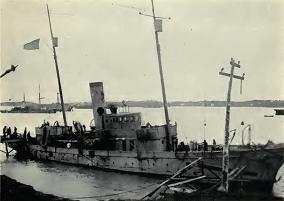
U. S. S. Christabel The smallest and oldest ship
in foreign service. The white star on the stack
means official credit for a submarine (Note:
this claim is not confirmed by post-war
research.)
|
|
| |
|
|
|
|
| |
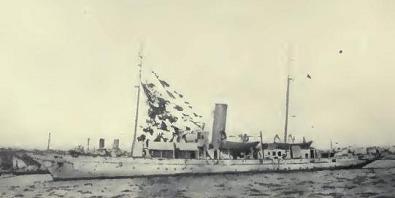
U. S. S. Rambler
|
|
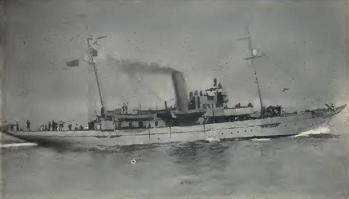
U. S. S. Wanderer
|
|
For over a month work had been
pushed to the utmost to prepare the yachts for
foreign service. Furnishings and decorations of
peaceful days were removed and stored in Brooklyn
warehouses. White sides and glittering brightwork
were hidden under coats of battle gray. Fore and
aft, three-inch guns were mounted, and guns of
smaller caliber were located on the upper decks.
Cutlasses and rifles lined bulkheads of panelled oak
or mahogany. Everywhere about the ships improvised
quarters, in former smoking-rooms, libraries and
sun-parlors, housed crews expanded by war-time
necessity to four or five times the original quota
required to operate the yachts in time of peace.
The six yachts anchored until the
morning of June 9 off Tompkinsville, S. I., New
York, and at 5: 30 A.M. stood out to sea at a
standard speed of ten knots, en route to Bermuda. On
the twelfth of June, the force arrived at St.
George's Bay, coaled; on the sixteenth again got
under way and shaped a course for the Azores.
The yachts arrived at Brest,
France, on the fourth of July, after a relatively
uneventful voyage, where they found the Corsair and
the Aphrodite, which had arrived ahead of them due
to their greater size which enabled them to lay a
direct transatlantic course. On July 14, 1917, the
squadron commander, Captain W. B. Fletcher, U. S.
N., with his staff, secured quarters on shore and
began the first actual active cooperation with the
French Navy against the enemy submarines. It is of
historical interest to note that a few hours before
entering the harbor, the Noma sighted a periscope. A
few hours later, the S. S. Orleans was torpedoed,
probably by the same submarine which the Noma
sighted, and her thirty-seven survivors of the crew
and the thirteen members of the United States naval
armed guard were brought into Brest by the Sultana.
During
the month of July, the yachts received a strenuous
introduction to the patrol duty, which consisted of
a constant patrol of defined areas of water, so
continuous and so thorough that the submarine
activities, hitherto in a large measure undisputed,
were materially hampered and the safety of the
convoys passing through these waters was
proportionately increased. On the afternoon of the
twenty-ninth of August, the U. S. S. Guinevere and
the U. S. S. Carola IV, of the Second Squadron of
converted yachts, arrived at Brest, and on the
thirtieth, Commander F. N. Freeman, U. S. N., with
the yachts U. S. S. Alcedo, U. S. S. Wanderer, U. S.
S. Remlik, U. S. S. Corona, and U. S. S. Emeline
came into the harbor, delayed by storms and with
badly leaking decks.
Due to the unusually fantastic
scheme of camouflage which disguised the ships of
the Second Squadron, these yachts were commonly
known as the ''Easter Egg Fleet,” every conceivable
color having been incorporated in a riotous speckled
pattern on their sides. (Note: U.S.S. Corsair -
Lieut. Com. T. A. Kittinger, U.S.N., U.S.S.
Aphrodite - Lieut. Com. R. P. Craft, U.S.N,. U.S.S.
Noma - Lieut Com. L. R. Leahy, U.S.N., U.S.S.
Kanawha - Lieut. Com. H. D. Cooke, U.S.N., U.S.S.
Fedette - Lieut. Com. C. L. Hand, U.S.N., U.S.S.
Christabel - Lieutenant H. B. Riebe, U.S.N., U.S.S.
Harvard - Lieutenant A. G. Stirling, U.S.N,, U.S.S.
Sultana - Lieutenant E. G. Allen, U.S.N., Captain
William B. Fletcher, U.S.N., squadron commander.)
On the fifteenth of August, the
Noma reported the first actual engagement with any
enemy submarine as follows: ''At 2: 17 P.M. in
position Lat. 47° 40' N. Long. 5° 05' W. sighted a
suspicious object bearing about 245° (per standard
compass), distance about 6,000 yards. Object was
made out to be a submarine on the surface heading
about 320° psc. A discharge was being emitted by the
submarine, very much like smoke and was very
misleading. Submarine was evidently charging her
batteries. At 2:20 P.M. went to "general quarters"
and closed in on submarine. At 2:24 P.M. opened fire
with port battery, distance about 4,000 yards. Fired
ten shots. Submarine fired three shots at this ship,
one striking about 500 yards ahead of the ship and
the other two shots well over and on the quarter. At
2:27 P.M. the submarine submerged. Proceeded to
vicinity of submarine, but did not see her again. At
2:35 P.M. resumed our course."
Although the foregoing was the
first actual engagement, the Noma on August 8, in
response to an S. O. S. call, joined the S. S.
Dunraven, which was badly disabled by gunfire from a
submarine. This ship had been shelled from astern by
the submarine, one shell having exploded in the
after magazine and disabled the steering gear. Soon
after, the submarine approached closer to the
Dunraven and fired a torpedo. The submarine was in
this position when the Noma came up on the opposite
side of the torpedoed vessel. Two depth charges were
dropped by the Noma on the spot where the submarine
submerged, but these being of the early type, failed
to detonate.
The next squadron of the patrol
force, Captain T. P. Magruder, U. S. N., in command,
reached Brest on the afternoon of September 18, and
consisted of the yacht U. S. S. Wakiva, the supply
ship U. S. S. Bath, and the trawlers U. S. S.
Anderton, U. S. S. Lewes, U. S. S. Courtney, U. S.
S. McNeal, U. S. S. Cahill, U. S. S. James, U. S. S.
Rehoboth, U. S. S. Douglas, U. S. S. Hinton, and U.
S. S. Bauman. With these also arrived six 110-foot
patrol vessels, under the French flag. Due to the
construction of the trawlers, which was soon proved
to be entirely unsuited for the hard sea service
required, they were withdrawn after a few weeks from
escort duty and fitted for mine-sweeping.
It was during this period that the
United States armed transport Antilles in convoy
with a group of three transports and store ships and
escorted by the Corsair, Alcedo, and Kanawha, was
torpedoed and sunk, on the seventeenth of October,
outside of Quiberon Bay. No sign of a submarine was
seen. The total number of persons on board the
Antilles was 237, of whom 167 were rescued by the
escorting yachts.
During the month of October, 1917,
the coal-burning destroyers U. S. S. Smith, U. S. S.
Preston, U. S. S. Lamson, U. S. S. Flusser, and U.
S. S. Reid, arrived from Queenstown where they had
been receiving training. They were accompanied by
the U. S. S. Panther, a supply ship, which had
acquired historical interest as a transport in 1898
during the war with Spain. The addition of this
small destroyer flotilla was of inestimable value,
for the yachts, until this time, had been required
to perform the entire patrol and escort duty,
including the deep-sea troop convoys for which they
were structurally wholly unsuited and inadequate.
It is interesting to imagine the
hopes and fears of those early days of our
participation. In the ancient port of Brest but a
few remnants of the French fleet remained. The
streets of the gray town were deserted. Gone were
the seamen that for centuries had given it its
glory; gone too were the young men, now fighting and
dying on the northern lines of France. Small indeed
must have seemed these first contributions from the
great ally beyond the Atlantic. A few converted
yachts, a few destroyers; that was all. And yet,
within the brief span of a year this almost deserted
harbor was to become dense with shipping. Great
transports were to swing at moorings beyond the
breakwater. Wasp-like destroyers were to ride at
their buoys in the inner harbor in rapidly
increasing numbers. Khaki-clad soldiers by the
hundred thousand were to look upon the gray town and
pass on to their duty in the north. And from
nothing, the establishment of the United States
Naval Forces in France was to expand, with
characteristic American enterprise, into a vast
coherent organization, embracing in its manifold
ramifications the complete machinery for the
successful accomplishment of the tremendous work in
hand.
| |
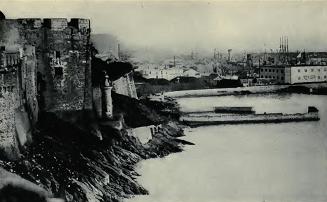
Brest - The old château and a bit of the inner
harbor
|
|
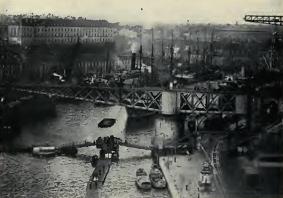
The landing at Brest
|
|
The first six months of our
activities on the French coast were in a large part
a period of experiment. The force was entirely
inadequate; the ships soon proved unsuited for the
work required and the officers and men of the
reserve force were new to the work. There has been
little glory credited to the work that was
performed, for it was at no time a kind of work with
which glory associates most freely. Here was
drudgery and danger; a silent service secretly to be
performed. It was work for which a destroyer
flotilla of the largest and fastest vessels would
have been none too good. But such vessels were not
available. The yachts were sent. As months passed by
came slowly the coal-burning destroyers. Later came
the great oil burners, and the yachts disappeared
into the obscurity of hazardous coastal convoys and
the deep-sea convoys of merchantmen in the rough
waters of Biscay.
On October 21, 1917, Captain
Fletcher was detached, and shortly after,
Rear-Admiral Henry B. Wilson arrived to take up the
command. To Captain Fletcher should be given the
credit for the inception and early organization of
our naval forces on the French coast, credit which
alone can offset the trials and disappointments of
those early days. With the arrival of Rear-Admiral
Wilson began the second and final period; a period
of constant organization and amplification.
Fortunately endowed in generous measure with those
executive qualities characteristic of an American
naval officer, Admiral Wilson was still further
happy in the possession of a diplomatic nature and
keen sympathy with the French people. With the
limited tools available, he planned and executed a
program which proved itself in its attainment of the
desired end. And, as the means for prosecuting his
purpose were increased, he developed his plans the
further to assure their more perfect accomplishment.
On November 27, 19 17, the
destroyers U. S. S. Roe and U. S. S. Monaghan
arrived at Brest from Saint-Nazaire. Utilized
previously for deep-sea escort duty from the United
States they had never before touched at a French
port, turning always in mid-Atlantic and returning
to the United States. On this occasion, however,
they had been assigned to escort the U. S. S. San
Diego, on which Secretary of War Baker made passage
to France, and arriving at Saint-Nazaire, found it
necessary to proceed north to Brest for coal. As
this duty was unforeseen, they were without coastal
charts and proceeded to explore their way through
the perilous mine and submarine zones with a large
ocean chart as their only guide. Ignorant of the
coast, they first explored the Bay of Douarnenez,
but finding no city there, they kept on up the
coast. Inasmuch as their ocean chart did not show
the channel of Raz de Sein, they did not find it,
and passed around it into the Iroise. A message was
sent to them to avoid the Iroise, but as that also
was not shown on their chart, they were forced to
ignore the warning. Happily, they finally reached
Brest without accident, where they were later
permanently joined to the destroyer force there. The
destroyer U. S. S. Warrington joined the Brest
forces at about the same time.
In the middle of December, the
torpedo boats U. S. S. Truxton and U. S. S. Whipple
reached Brest, and shortly after, arrived the U. S.
S. Wadsworth, the first thousand-ton destroyer to be
assigned to the French waters.
In the forepart of 1918, the
Stewart and Worden, two of our oldest torpedo boats,
made a hazardous but successful transatlantic
passage in the extreme weather of midwinter. On
February 18, 1918, the repair ship Prometheus, the
torpedo boat Macdonough and the converted yacht
Isabel moored in the harbor, and with the passing
months the fleet was further augmented by the
arrival of the destroyers Porter, Wainwrite, Jarvis,
O’Brien, Benham, Winslow, Drayton, Gushing, Tucker,
Burrows, Cummings, Ericsson, Fanning, and McDougal.
These were followed later by the first of the new
flush-deck destroyers: Little, Sigourney, and
Conner; and about a month before the signing of the
armistice these were followed by the Taylor,
Stringham, Bell, Murray, and Fairfax. A fourth
flotilla of yachts arrived during February, under
the command of Commander David F. Boyd, U. S. N.,
and included the U. S. S. Nokomis, U. S. S. Rambler,
and U. S. S. Utowana and the tug Gypsum Queen.
Another yacht, the U. S. S. May, was also added to
the force, having proceeded to Brest from Portugal,
where she had left a number of submarine chasers
which she had escorted across the Atlantic. In
addition to these vessels were also added during the
forepart of the year, the tugs Barnegat and Concord
and the repair ship Bridgeport. On the eleventh of
November, 1918, when hostilities were suspended by
the armistice, the United States Naval Forces in
France comprised a total of thirty-five destroyers,
five torpedo boats, eighteen yachts, eight tugs,
nine mine-sweepers, three repair ships and one
barracks ship, three tenders, and one salvage
vessel.
Much has appeared in magazines and
newspapers of the actual debarkation of American
troops on French soil. Of those landing in England,
or the ports of other countries, we are not here
concerned. It is the purpose of this narrative to
deal solely with the activities of the American
Naval Forces in France, and accordingly only with
those troop ships and store ships which sailed from
American ports directly to ports in France. The
first American troops reached Saint-Nazaire on June
26, 1917. Perhaps never in the world's history, has
the deeper and finer sentiment of a nation been so
thoroughly aroused as on that famous day when the
first few thousands of khaki-clad soldiers touched
foot on the soil of France. A nation by nature of
the deepest sentiment, the people of this seaport
town, realized in this slender vanguard the vivid
expression of a friendship begun in our own struggle
for national freedom and sustained for a century and
a half with almost unbroken continuity.
During the second half of 1917, a
constantly increasing flood of American soldiers
were transported in safety to the shores of France.
With the new year, a greater volume began to arrive
and in the month of January, 25,280 men were landed.
February showed a slight loss, with a total of
17,483, which was offset by the total of 53,043 in
March and 62,615 in April. In May, the full flood
began with a total of 119,110. In June, 104,249 were
landed, a number which increased in July to 133,993.
There was a sudden drop in August to 93,376, but the
September quota of 143,253, established a new
record, closely followed by a total of 107,547 in
October. The grand total for the ten months of 1918
was 859,949.
There is no more inspiring sight
than the arrival of a troop convoy and the
description of a single instance may illustrate, as
characteristic, any of the one hundred and two troop
convoys which arrived during these ten months of
1918. At dawn the convoy of eight troop ships which
had been proceeding in a double line of four ships
each, formed single column, with three destroyers on
either flank. The sea was calm and the sun rose in a
soft-blue, cloudless sky. On the eastern horizon a
white lighthouse lifted sharply from the thin line
of the coast. The great troop ships, famous liners
of other days, rose and fell heavily on the low
swells, their high sides stripped and blocked in a
strange dress of blue, gray, white and black
camouflage, their decks brown with a solid mass of
soldiers straining their eyes to catch a first
glimpse of France. High overhead, two great yellow
French dirigibles moved with smooth rapidity. From
four gray hydroplanes, soaring in wide circles, came
the distant reverberation of motors. On either hand
the destroyers, lean, lithe sea-whippets, shook
their dipping bows and rolled in the swells with a
quick jerking motion. Over the water came the sound
of music; an Army band was playing on board the
nearest transport. The convoy passed into the
channel. On the south, great brown rocks lifted from
the sea, and on either side of the entrance to the
harbor, the black cliffs of Finistere, like twin
Gibraltars, marked the approach. The convoy,
steaming slowly, moved up the channel. The broad
blue harbor of Brest unfolded, crowded with
shipping. In the outer harbor great steamers swung
at their moorings, and behind the breakwater the
water was gay with camouflaged vessels, clusters of
destroyers and the gray hulls of two great repair
ships. Beyond the harbor swung the circle of the
green hills of Finistere, and on the left the gray
and ancient city of Brest rose sharply from the
historic fortress at the water's edge. Quietly the
destroyers slipped into the inner harbor and the
transports anchored outside the breakwater. They
were "over;" delivered safely through the danger
zone by the United States Naval Forces in France.
| |
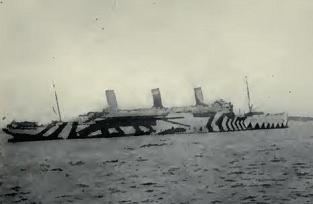
The Leviathan
|
|
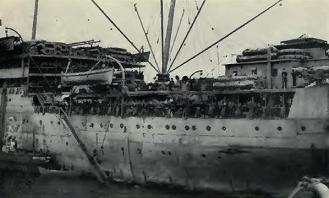
Troop Ship at Brest
|
|
| |
|
|
|
|
| |
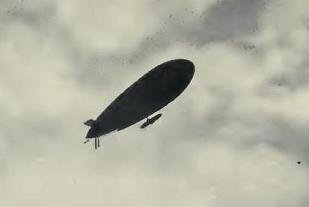
A French Dirigible
|
|
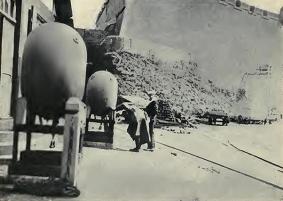
German Sea Mines
|
|
Such, in general, was the work of
the Navy in French waters during the sixteen months
of its activity. It was a labor unenlivened by those
inspiring engagements between ships of a class which
marked our naval activities in these waters a
century and a half before. Rather, it was a struggle
with a force secretive, elusive, and mysterious.
There were thrusts in the dark from an unseen enemy;
there were engagements fought and won between ships
invisible to each other. Never could there be a
moment of relaxation; never did an empty ocean, blue
under a summer sky or gleaming in the moonlight,
assure the absence of the enemy. Great vessels under
escort were torpedoed, vessels of coastwise convoys
and vessels of the deep-sea traffic were sunk, but
small was the percentage of loss compared with the
numbers of the mighty argosies that in safety sailed
the sea and of greatest significance stands the fact
that not one loaded transport was destroyed or the
life of a single passenger lost. Few were the
absolute confirmations of the destruction of
submarines, but later events have disclosed a
mortality that does compliment to Yankee
perseverance and the depth charge, that frightful
enemy of the submarine, which took lavish toll of
the sea-wolves of the underseas.
CHAPTER
II
BUILDING
THE
MACHINE
THE arrival of Rear Admiral Henry
B. Wilson at Brest on Thursday, November 1, 1917,
and the hoisting of his flag on the U. S. S.
Panther, marked the beginning of the second and
final period of our naval activities in French
waters. On the staff of the Admiral were Commander
John Halligan, Jr., U. S. N. Chief of Staff,
Lieutenant Mahlon S. Tisdale, U. S. N., and
Lieutenant J. G. F. Reynolds, U. S. N. R. F., who
had accompanied Admiral Wilson from Gibraltar.
Admiral Fletcher's staff was assimilated and this
small nucleus grew to some seventy officers before
the armistice was signed. It is impossible
adequately to chronicle the development of these
months of organization and accomplishment. From the
first establishment of Captain Fletcher, the
organization was consistently developed to meet new
requirements constantly arising, requirements
necessitating the occupation of quarters on shore
which finally extended to the complete equipment
which existed at the final suspension of
hostilities. Offices were acquired and new space was
constantly added. Quarters for men on shore duty
were provided. Offices for the pay department were
secured; a department that at the close of the war
was in itself a complete organization, handling a
volume of business undreamed of by any of our own
Navy Yards, with the probable exception of the
Brooklyn Navy Yard, in the former days of peace. To
maintain good order throughout the city, a naval
patrol was established. A great post office, which
in one day received fifteen thousand sacks of mail,
was created. Coal, oil, and water facilities for the
ships were planned and arranged for. Communication
systems were instituted. And in all these various
activities, a cooperation was maintained with the
French authorities, both maritime and civil,
unbroken in the consistent spirit of enthusiastic
friendliness.
The rapidly increasing importance
of the United States Naval Forces in France required
a coherent and yet flexible organization under
single leadership, and on the twelfth of January,
1918, after calling Admiral Wilson to London for
conference the first definite amplification of the
organization of the United States Naval Forces in
France was outlined by Vice-Admiral Sims, Commander
United States Naval Forces operating in Europe, to
Rear Admiral Wilson. Under this new organization,
Admiral Wilson received the title of
"Commander United States Naval Forces in France" and
took command of all United States naval vessels
operating in French waters. As a result of this
comprehensive command, the organization was
naturally divided into two parts: the naval forces
afloat, including all ships assigned to duty in the
Channel and the Atlantic coasts of France, and the
Port Organization and Administration, comprising the
three districts of Brest, Lorient, and Rochefort,
with an officer of captain's rank in command of each
of these districts.
Aviation, under the command of
Captain H. I. Cone, was also included under the
command of Rear-Admiral Wilson, but due to the many
problems in this new branch of naval activities, a
free hand was given to Captain Cone in the building
up and perfecting of the naval aviation service and
it may be considered practically a distinct
organization during the phase of construction and
until the stations began to operate against the
submarines.
Commander W. R. Sayles, U. S. N.
(naval attache in Paris) was placed in command of
the Intelligence Service, and Captain R. H. Jackson,
U. S. N., became an officer on Admiral Wilson's
staff, to act primarily as liaison officer between
the Admiral and the French authorities, although the
right naturally remained to Admiral Wilson to deal
directly with the French Ministry of Marine if he
should so desire. As an addition to the Intelligence
Service, a counter espionage service was organized
under the command of Commander Sayles, and in order
to clarify the work, the various activities were
separated into six principal fields:
Naval Forces Afloat; Port
Organization and Administration; Aviation;
Intelligence; Communication; Supplies and
Disbursements.
In regard to the control of
shipping, it was determined that all troop and cargo
transports and other vessels flying the American
flag should be escorted to their wharf, anchorage or
buoy by the Navy, and that thereafter, their
subsequent movements, until they should be ready to
leave port, should be controlled by the Army or
Navy, according to whom their cargo belonged, and
that, upon leaving port, they would again revert to
naval control.
In accordance with this outline,
Admiral Wilson designated the three districts as
follows:
Brest to include the territory
extending from Brehat to Penmarch, including
Ushant; Lorient, the territory from Penmarch to
Fromentine, including Belle-Ile, and Rochefort,
the territory extending from Fromentine to the
Spanish line and including the outlying islands.
The district commander in charge of
each of these districts received immediate control
of operations of all vessels placed under his
command and was further charged with the
responsibility of repairing and supplying of vessels
assigned to his district; the development and
maintenance of adequate naval port facilities; the
establishment and maintenance of all communication
with the Commander United States Naval Forces in
France, the prefet maritime, the naval port officer
of the district, and the other district commanders
and the supervision of American shipping and of
United States naval personnel on merchant ships.
Naval port officers at all of the
principal ports, were established, reporting
immediately to their respective district commanders.
The duties of these port officers were primarily to
facilitate the berthing, discharging, and sailing of
United States troop and store ships, a duty which
included all of the arduous details which constantly
present themselves whenever shipping in any quantity
is present. Among the many duties assigned to port
officers, the following were perhaps of major
importance:
To cooperate with the United States
Army and the French authorities in the despatch of
vessels; to keep the Commander United States Naval
Forces in France and the district commander promptly
informed of the arrival and the departure of all
United States vessels; to obtain from the commanding
officers or masters of these vessels upon their
arrival, all interesting information regarding the
incidents of their voyage and their particular
needs; to inspect the United States naval armed
guard and radio men on all United States vessels,
other than those regularly commissioned in the
United States Navy and report on their efficiency;
to assist in supplying these vessels with necessary
fuel and supplies; to pay the armed guard and
furnish them with clothing and small stores; to
investigate offences committed by United States
naval personnel on vessels other than those
regularly commissioned United States naval vessels;
to investigate and take action on all admiralty
cases involving United States Navy; to keep the
Commander United States Naval Forces in France
informed of the readiness of all vessels and of the
speed which they were capable to maintain through
the danger zone; to familiarize the masters of ships
with the precautions and the prescribed convoy
scheme to be followed within the danger zone; to
furnish each convoy and its escort commander, prior
to sailing, with the latest information regarding
submarine and mine activities and to keep the
commander in France constantly informed as to the
amount of Navy coal on hand, expended and received.
It has been ever a part of the
Navy's duty to stand ready to assume responsibility
for the fulfillment of whatever work might be
required to prosper the best interests of the
Nation, for which the Navy has been and must
continue to be its outward manifestation throughout
the world. To create an organization, such as
conditions in France required, sufficient not only
to meet temporary needs, but also future
requirements and at the same time to carry on an
active warfare with a powerful enemy, was a
commission of the most grave responsibility, for it
required not only the abilities of trained men of
business, endowed with native American energy and
promptness of decision, but there were also required
those traits which are presumed to attach solely to
trained diplomats. For in all this tremendous
operation and creation, it was necessary to maintain
the utmost harmony and cordiality with a people
speaking a different tongue and accustomed to those
more composed and conservative methods of
accomplishment generally characteristic of an older
nation.
| |
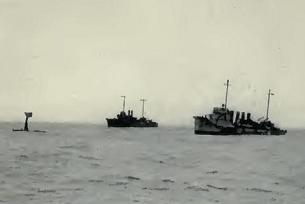
A sea plane makes a bad dive. Destroyers to the
rescue
|
|
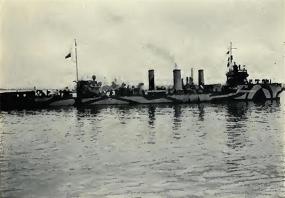
The destroyer Monaghan
|
|
| |
|
|
|
|
| |
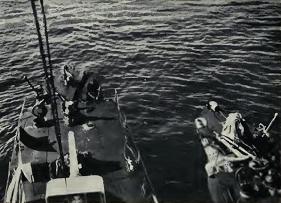
The hammer-head bow of a destroyer
(possibly the bow of Jarvis after she had rammed
Benham)
|
|
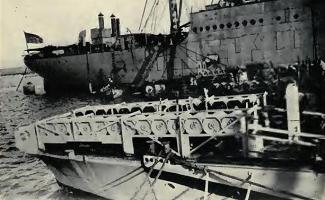
Depth charges on the stern of a destroyer
|
|
Throughout the entire history of
our naval cooperation with the French nation, a
spirit of cordiality and cooperation was
consistently maintained. Nor were these relations
broken by a single incident to mar the perfect
accord. The following telegram was received by
Admiral Wilson on July 1, 1918, from the French Vice
Admiral Schwerer and seems particularly felicitous
in the exact expression of the spirit existing
between the two nations:
On
July 4, 1917, there arrived in our waters the
first eight ships of war sent to France by the
United States to fight with us against the enemy's
piracy. These vessels were the yachts Harvard,
Vedette, Kanawha, Sultana, Christabel, Noma,
Corsair and Aphrodite. Since that period these
vessels have constantly collaborated with us in
the protection of convoys and we have all been
witnesses of the ardor and the devotion brought by
their personnel to the difficult and sometimes
ungrateful tasks of the patrols.
This
squadron was the vanguard of a flotilla of ships,
each day more numerous and more powerful, which
arrived from the other shore of the ocean to take
part in the fight.
At
the moment when the anniversary of the arrival in
Brest of this vanguard approaches, I am sure that
I am the interpreter of all the officers, petty
officers, and enlisted men of the divisions of
Bretagne, in addressing to our American comrades
the expression of our fraternal esteem and of our
warm admiration of your great nation which has not
hesitated to throw itself into the most terrible
of wars for the defense of Right, of Liberty, and
of Civilization.
(Signed)
Vice Admiral Schwerer,
Commandant
Supérieur des Divisions de Bretagne. Brest, July
1, 1918.
On July 4, 1918, the following
telegram was received by the Commander United States
Naval Forces in France, from the Minister of Marine:
At
the moment when the magnificent battalions of the
American Army are marching in Paris past the
statues of our cities unjustly occupied by the
enemy, thus affiirming the high ideals of justice
which lead them to fight by the side of our
soldiers, I am particularly happy to address to
you my most cordial regards in recognition of the
perfect and devoted cooperation which our naval
forces in Brittany have not ceased to find with
the American naval forces placed under your high
direction and the systematic harmony of views and
sentiments which has not ceased to reign between
us.
Rear-Admiral Wilson replied:
To
the Minister of Marine:
It
is a great honor and satisfaction to receive the
cordial good wishes expressed in your message of
today. The American Navy is proud of its privilege
of working with the French Navy, a service for
which we have the highest admiration. Our personal
association with the flag officers of your Navy
has been an inspiration to me.
(Signed)
H. B. Wilson.
On September 21;, 19 18, Rear
Admiral Henry B. Wilson, U. S. N., Commander United
States Naval Forces in France was promoted to the
rank of vice-admiral, U. S. N., and his flag was
hoisted on the flagship Prometheus,
There are times when only
statistics can giye a definite conception, and a few
figures selected from the mass of data relating to
these impressive operations may indicate in some
measure the scope of the accomplishment. From
nothing, on July 1, 1917, the United States Naval
Forces in France had grown by October 1, 1918, to an
establishment of 22,111 officers and men; of these
1,422 were officers. Afloat, the personnel numbered
601 officers and 7,480 men. Of the shore forces, 160
officers and 2,187 men were distributed among the
three base organizations; 71 officers and 207 men
among the port offices, 578 officers and 9,789 men
among the 16 naval air stations; 24 officers and 488
men with the naval railway battery; 18 officers and
556 men with the high power radio detachment and 27
officers and 58 men on detached staff service.
During the first nine months of
1918 an approximate total of 752,402 troops was
convoyed safely through the danger zone and landed
at French ports. On one day alone sixteen ships
containing over forty thousand men were brought in
safety into a single port. Two hundred and sixty
convoys, comprising 1,499 vessels, were convoyed,
during the same period through the zone, proceeding
either to French ports or homeward bound. And this
was accomplished by a fleet, all told, which reached
eighty odd vessels only a few weeks before the
armistice was signed, and was manned by
approximately eight thousand officers and men.
During the closing months of the
war, the activities of the base at Brest assumed
proportions far in excess of the anticipation of any
of those who contributed to the early days of its
establishment. Repairs to escort vessels,
transports, merchant ships, and vessels wrecked by
storm or collision, or torn by torpedoes,
necessitated operations similar to those required by
the most modern Navy Yards in the United States.
Repair shops afloat and on shore were working in
shifts, in order that the vast volume of work might
be accomplished. The administrative force had been
constantly increased to keep pace with these
developments and a continuously growing number of
enlisted men had required additional barracks on
shore.
CHAPTER
III
IN THE
PATH OF THE SUBMARINE
In the many engagements between
Allied vessels and German submarines in French
waters the fortitude of the officers and crews of
the smaller merchantmen and particularly of the
French fishing vessels afforded many dramatic
instances. Due to the limited number of French and
American patrol vessels it was but natural that many
of the smaller vessels took a "long chance" and
endeavored to make their way unescorted along the
coast. Many of these vessels were attacked and a
large number were destroyed; but out of the total
number of engagements there are several which
particularly illustrate the temper of the French
seaman in the face of almost overwhelming odds.
At about eleven o'clock of the
morning of December 4, 1917, the St. Antoine de
Padoue, a three-masted sailing vessel left Britton
Ferry for Fecamp. She was making about three or four
knots in a S. S. E. direction when a shell fell
about two hundred meters off the starboard bow and a
violent explosion was heard astern. The pilot who
was standing on the poop deck with the captain saw
the submarine which was headed N. E. at a distance
of four thousand meters on the port quarter.
“General quarters " was immediately sounded; the
captain ordered a zigzag course to be followed in
order to confuse the aim of the submarine, and
opened fire with his own guns. After seventeen shots
had been fired by the St. Antoine, the submarine
submerged and disappeared. The engagement had lasted
fifteen minutes and no damage was done to the
sailing vessel. But fifteen minutes later the
submarine reappeared and resumed firing at a
slightly increased distance. The first shell fell
short on the starboard side. The captain promptly
responded with his stern gun and resumed his zigzag,
but within a few minutes the sighting piece of the
gun was shot away and damage to the breech put the
gun temporarily out of action. Undaunted, the
captain maneuvered to bring his forward gun into
action, but a shot from the submarine struck the
port side of the sailing ship, inflicting severe
damage. In spite of the heavy fire which continued,
the men stuck to their posts and continued what
seemed to be a hopeless struggle. At the darkest
moment, however, a British hydroplane made its
appearance and caused the submarine to submerge.
This was the third time that the St. Antoine had
escaped after having been attacked by German
submarines and the captain had already been cited as
a result of these engagements.
| |
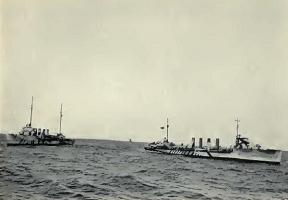
Destroyers waiting for an incoming convoy
|
|
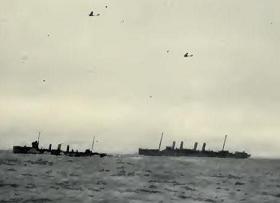
Troop ship escorted by a destroyer and two sea
planes
|
|
| |
|
|
|
|
| |
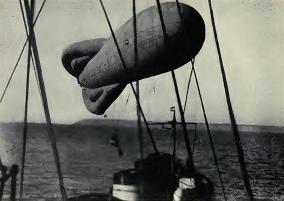
Observation balloon on a destroyer
|
|
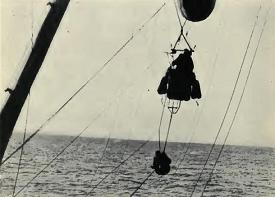
The
balloon
going up
|
|
On another occasion, the St.
Antoine de Padoue was engaged in fishing off Fecamp.
While the crew were attending to their nets, a small
boat with two leg-o-mutton sails appeared on the
horizon at a distance of two or three miles. In
waters frequented by fishing boats the appearance of
a craft of this nature would not normally attract
attention, but in this particular instance the
vessel sighted seemed to be pursuing a course
parallel to the course of the St. Antoine, at a rate
of speed in excess of that justified by the small
size of her sails. The suspicions of the captain
were promptly aroused and he sent his crew to battle
stations. Gradually the courses of the two ships
converged and the St, Antoine fired a shot, hoping
that the suspicious vessel would show a signal. No
signal, however, appeared and a few minutes later
the sails were hauled down and a conning tower was
clearly seen in silhouette against the horizon. For
some reason unknown, no attack was offered, probably
due to the apparent readiness which the captain of
the St. Antoine showed for battle; and shortly after
the submarine disappeared and the St. Antoine
proceeded on her course.
Another interesting attack was
reported as having occurred on the ninth of January,
1917, against the French steamer Barsac, bound from
Brest to Le Havre. The Barsac, entirely darkened,
was proceeding at a speed of about ten knots, when
at 6:35 P.M. a torpedo suddenly exploded against the
side, opposite No. 3 hatch, promptly filling the
engine-room with water. The ship filled rapidly by
the stern and sank in three minutes. No one on board
saw either the submarine or the torpedo.
With the utmost calmness the crew
manned the boats, the captain alone remaining aboard
the stricken vessel. When the ship went down the
captain was dragged after her by the suction, but
coming to the surface was rescued about twenty
minutes later by one of the ship's boats. The
surviving members of the crew were finally picked up
by a patrol boat, but eighteen men were lost
On December 21, at a little after
one o'clock in the morning the Portuguese steamer
Boa Vista in convoy with five other ships escorted
by two French patrol boats, the Albatros and the
Sauterelle, were proceeding north, enroute for
Quiberon. The sea was calm and the night clear and
brilliant although there was no moon. No sign of
submarine activities appeared on the still water.
Suddenly, the Boa Vista was struck by a torpedo on
the starboard side a little forward of the bridge.
For half an hour the ship sank slowly by the bow.
The patrol boats "stood by," rescuing the crew and
endeavoring to take in tow the lifeboats which she
had launched. Suddenly the conning tower of the
submarine appeared at a distance of five thousand
meters and fired a second torpedo at the Boa Vista
which sank rapidly and disappeared five minutes
later.
Early in January, the steam trawler
St. Mathieu left Brest on her way to the fishing
grounds about one hundred miles S. S. W. of Raz de
Sein. In the morning of the sixth, when
seventy-seven miles S. W. of Belle-Ile, the lookout
sighted a boat on the horizon and a few seconds
afterward a shell passed over the St. Mathieu. The
captain promptly hauled in his nets, sent his crew
to battle stations and heading for the enemy, opened
fire with his bow gun. A few minutes later, a shell
from the submarine shattered the upper part of the
bridge, wounding the man at the wheel and another
near the bow. Encouraging his crew, the captain of
the trawler continued his action until another shell
from the submarine mortally wounded three of the
guns' crew, but undaunted, the only survivor
continued to fire until the ammunition was
exhausted. The submarine was now relatively near the
trawler and her fire was extremely accurate. By this
time, out of a total crew of thirteen on board the
trawler, four were killed, four badly wounded, and
all of the remaining were suffering from minor
injuries.
It was now necessary to abandon
ship and the captain with the survivors put off in a
small boat. A few minutes later the submarine sank
the St. Mathieu by gunfire and promptly submerged.
Then followed thirty hours of great suffering on the
part of the crew of the trawler, all of whom were
more or less wounded. A heavy sea was running and
navigation was difficult. The night was very dark.
Toward morning a patrol vessel heard the cries of
the sailors, but in her attempt to effect a rescue,
ran into the lifeboat and capsized it, with the
result that four of the crew were drowned. The
survivors of the St. Mathieu were landed at La
Palice on the morning of the eighth of January and
later the captain was awarded the Military Medal and
all of the members of the crew were cited in orders.
At about noon on the tenth of
October, 1917, the captain of the French ship
Transporteur, was exchanging semaphore signals with
the Afrique II, a French patrol boat, when he
noticed in the sunlight, at a distance of about
three hundred meters, the wake of a torpedo coming
toward him, a little forward of the beam. He
immediately steamed "hard-right," reversed his
engine and warned his escort by whistle.
Unfortunately his action, although prompt, proved
unable to avoid the path of the torpedo, which,
striking the ship at the water line, caused a
terrific explosion and brought down the forward
mast. The ship listed and forty seconds later the
water was almost even with the forecastle. For a
brief period the vessel remained standing almost
perpendicular, its propeller continuing to turn
rapidly in the air; then perpendicularly and like an
arrow shot from a great height, it dived into the
sea. Of the twenty-four men comprising the crew,
twenty-one survivors were rescued by the Afrique II,
while swimming in the wreckage.
The engagement of the French
steamer La Ronce with an enemy submarine, is another
example of French fortitude. Sighting a torpedo on
the port beam headed in a direction which would
undoubtedly bring it up opposite the engine-room,
the officer of the deck put his rudder "hard-left"
with the result that the torpedo exploded by No. 4
hatch, tearing a large hole in the side of the
vessel. The stern gun being destroyed, the captain
manned his forward gun, but could not locate the
submarine. Little by little, the ship settled by the
stern and the after part of the deck being
submerged, the water began to enter the engine-room
through the hatchways. Seeing that it was impossible
to keep his vessel afloat much longer, the captain
ordered her to be abandoned and the crew embarked in
boats in a heavy sea. As several of the boats had
been destroyed by the explosion, those that were
launched were overloaded and when the order was
given by the captain to " push offf," he realized
their crowded condition and remained on board the
sinking ship with the engineer officer and radio
officer and with them went down with the ship.
The Voltaire II was bound for
Nantes. Sailing from Gibraltar on the eighth of
December, 1917, the captain opened his secret;
instructions, issued in the event of his leaving the
convoy, and proceeded about one hundred and forty
miles in a new direction. The night was very dark
and the ship was without lights. At twenty minutes
to four a torpedo struck the ship near the stern,
tearing loose the mainmast and throwing it on the
bridge. The wireless antenna was carried away by the
falling mast and the water rose so rapidly that it
became impossible to use the auxiliary antenna. Due
also to the rapidly rising water, the boats were
jammed against the davit-heads and with the
exception of the port whaleboat, which was launched
with four men, none of them could be lowered. The
ship disappeared in three minutes, taking with her
the captain and the greater part of the crew. About
twenty-four sailors were rescued by the whaleboat.
Sail was made and the boat was headed for Belle-Ile,
in a heavy sea. It was cold and the boat was so
overloaded that it was difficult to keep it afloat.
The men for the most part, were about half dressed
and became rapidly exhausted. During the evening of
the twelfth, the light of Penmarch was seen,
but soon after the mast broke and it became
necessary to continue with the oars. A few hours
after, they passed a convoy and later a single ship,
but their signals of distress were unnoticed.
Finally, at noon they were sighted by the French
trawler which rescued the men and took them to
Lorient. Two died from the cold and exposure. At no
time before or after the torpedoing did anyone see
the submarine or its periscope.
| |
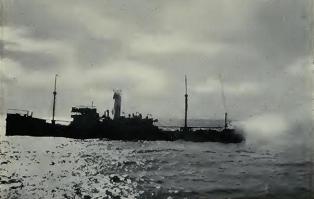
The British mystery ship Dunraven, under fire from
a submarine. The white smoke at the stern is from
an exploding shell
|
|
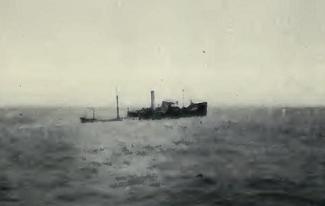
The
Dunraven sinking
|
|
| |
|
|
|
|
| |
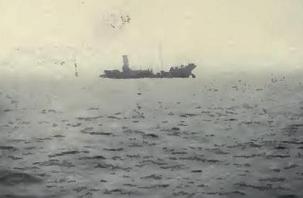
The
Philomel
(British) sinking after being torpedoed
|
|
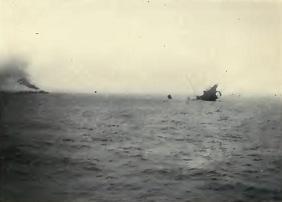
The
last of the Philomel
|
|
On her way from St. Malo, to join a
convoy of sailing vessels, the French schooner
Jermaine was attacked by a submarine which opened
with four shells and followed with a volley of fire,
meanwhile circling the sailing vessel. The Jermaine
was ably commanded by a former sergeant of colonial
infantry who promptly organized the crew and
prepared to defend the ship at all hazards. The sea
was running so high that it was impossible to see
the submarine except at rare intervals. Climbing
into the rigging, in order personally to watch the
shots which were fired by the Jermaine whenever the
enemy became visible between the troughs of the sea,
the captain tacked to run with the wind in order to
make use of his two guns. So accurate was the fire
of the sailing ship that at the fourth shot from the
Jermaine, the submarine abandoned the struggle and
rapidly changed its course.
The British ship Austradale left
Milford Haven on the sixteenth of October, 1917, in
a convoy of twenty-five ships, proceeding in columns
of eight. Her position was No. 1 in the left column.
About three days out, the Austradale sighted at a
distance of approximately three miles, an object
which appeared to be a capsized fishing boat. The
captain gave the signal “Suspicious object sighted "
and now believes it was put there by the submarine
in order to divert his attention from the subsequent
attack which came from the opposite side. At all
events, while watching the object, the ship was
suddenly torpedoed on the port side, on a line with
the engine-room, and sank in three minutes. The
forty-five surviving members of the crew embarked in
a whaleboat and two dinghies. The boats were well
provided with food and as danger was imminent, the
convoy proceeded and the small boats were soon lost
in the night. For seven days, the crew navigated
their small craft in heavy seas, covering a distance
of 330 miles. During this period, one man became
insane and jumped into the sea. Leaks developed
which required constant baling and reduced the
survivors to a state of almost complete exhaustion.
Two of the dinghies reached Port Kerrel, but one of
the men later died of exhaustion. The whaleboat,
containing twenty-four men, was never heard from.
On September 16, 1918, the Rambler
rescued forty-one survivors from the British S. S.
Philomel and carried them into Lorient. The Philomel
was the leading ship of the right column of a
south-bound convoy from Brest to La Palice and the
Rambler was one of the escorting vessels. No
submarine or torpedo was seen at any time, nor was
the submarine detected by the listening devices. The
Philomel was struck on the starboard side, under the
bridge, and, following the explosion, she swung to
starboard out of the column and was immediately
abandoned. At 6:14 P.M, about thirty minutes after
being struck, the Philomel began to sink by the bow,
taking a very sharp angle until her bow seemed to
rest on the bottom. A minute later she disappeared
from sight, with steam escaping and her whistle
blowing.
Relatively few were the disasters
which befell American troop and store ships. And of
those sinkings which occurred, the large majority
were among the empty vessels homeward bound. Perhaps
the slightly inferior escorts which took out the
returning ships may have been the reason, but it is
more probable to suppose that the enemy found a
resistance on the part of the eastwardbound convoys
which would have been unmeasurably intensified by
the knowledge, on the part of the officers and crews
of both escort and convoy that American lives other
than their own and property necessary for the
prosecution of the war were resting in their
protection below the vessels' decks.
Particularly to the credit of all
concerned, was the salvaging of the ships West
Bridge, Westward Ho, and Mount Vernon. Only through
the indomitable perseverance of the officers and men
were these wounded vessels brought into port. The
story of their rescue is one of the silent epics of
the war.
The torpedoing and rescue of the
Westward Ho has been told in a previous chapter but
the incidents attendant on the attacks on the West
Bridge and Mount Vernon deserve mention in this
narrative.
There was unusual activity of enemy
submarines to the west of the Bay of Biscay during
the early part of August, 1918, and three vessels,
the U. S. S. A. C. T. Montanan of 6,659 tons gross,
the U. S. S. A. C. T. West Bridge of 8,800 tons
gross, and the U. S. S. A. C. T. Cubore of 7,300
tons gross were torpedoed.
The Montanan was struck when
proceeding in convoy at about 7 P.M. on August 15
and sank at 3 P.M. on the following day. The yacht
Noma, acting in the escort, took aboard eighty-one
survivors and reported that five of the personnel
were missing.
The U. S. S. A. C. T. Montanan
reported that three torpedoes were fired. Of these
she succeeded in dodging two, but was hit by the
third torpedo abreast of the after end of the
engineroom. The explosion smashed a boat and put the
radio completely out of commission. The ship settled
rapidly and it was in abandoning ship that the two
members of the armed guard were drowned.
At one o'clock in the morning on
August i6, the West Bridge was torpedoed within a
few miles of the spot where the Montanan was sunk.
She was proceeding in the same convoy, but had
fallen back due to engine trouble and for some hours
prior to her attack her engines had stopped
entirely. While lying in this extremely vulnerable
position, she was struck by two torpedoes in quick
succession, the second torpedo being visible at the
moment when the first torpedo went home. The
Concord, Smith, and Barnegat were despatched to her
assistance, but the destroyers Drayton and Fanning
which were standing by her, were required to leave
her on the afternoon of August 16 to join a convoy.
One officer and three men were missing, probably
killed by the explosion in the engine-room. The
ninety-nine survivors were taken into Brest by the
U. S. S. Burrows.
At the time of the arrival of the
West Bridge in Brest, it was calculated that only
one per cent of the normal buoyancy of the hull
before loading, remained. The calculated buoyancy
having been reduced from ten thousand tons to one
hundred tons.
The Cubore was struck on August 15
at ten o'clock in the evening and sank an hour
later. Fifty survivors including the captain and the
armed guard were taken off by the French gunboat
Etourde.
The Westover of the Naval Overseas
Transportation Service was torpedoed on the morning
of the eleventh of July, 1918, and sank forty
minutes later. The vessel left New York in convoy,
but it had been forced to drop behind because of
engine troubles; due primarily to the inexperience
of her engineer force with turbine machinery. These
troubles were later overcome and at the time she was
torpedoed, the Westover was making her speed and
endeavoring to overtake the convoy. She was struck
by two torpedoes. The first struck on the starboard
side, abaft No. 3 hatch and the second aft on the
port side. Her cargo contained 1,000 tons of steel,
2,000 tons of flour, 10 locomotives and 14 motor
trucks, a deck load of 400 piles and 250 tons of
second-class mail.
The Warrington arrived on the scene
within a few hours of the time of the sinking of the
vessel. Five boats containing the survivors made the
French coast in the vicinity of Brest; but three
officers and eight enlisted men were lost.
On September 5, 191 8, the U. S. S.
Mount Vernon, westward bound from Brest for the
United States was proceeding in company with the U.
S. S. Agamemnon. At a little before eight in the
morning, her watch sighted a submarine forward of
the beam, in a position between the Mount Vernon and
the Agamemnon. The Mount Vernon immediately dropped
five depth charges and fired one shell in the
direction of the periscope. Ten seconds later the
ship received the torpedo amidships on the starboard
side, between fire-rooms three and four, killing
thirty-five of the engine and fire-room force and
wounding twelve. The Mount Vernon accompanied by
three destroyers started to return to Brest at a
speed of six knots, which was later increased to
fourteen knots, arriving at Brest about midnight;
the Agamemnon continued her voyage westward.
| |
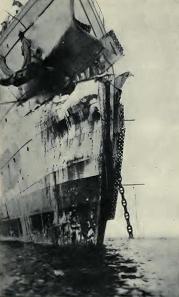
The
bow of the von Steuben after collision
with the Agamemnon
|
|
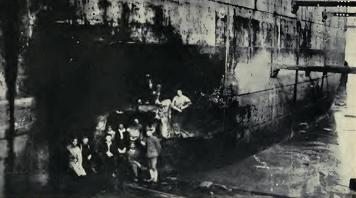
The
Mount Vernon in dry-dock showing the hole torn in
her
side by a torpedo
|
|
On receipt of the news of the
disaster, the Sigourney, with two other destroyers
and the U. S. S. Barnegat and Anderton were sent out
from Brest to assist in escorting the Mount Vernon
into port. At the time of her departure from Brest,
the Mount Vernon was drawing twenty-nine feet aft.
On her return she was drawing thirty-nine feet, five
inches aft and thirty-three feet forward; four of
her fire-rooms being completely flooded. She was
also listing 10° to port. From the time the torpedo
struck the ship until its arrival in dock, in Brest,
all of the officers and men worked untiringly on
pumps, handy-billies, and buckets, putting
additional shores on the bulkheads and reinforcing
hatches and doors. The Mount Vernon docked at Brest,
repaired and later was again put into commission.
The U. S. S. Buenaventura, an
American cargo transport of 8,200 tons, sailed from
Le Verdon in convoy on the fourteenth of September,
1918, and was struck by two torpedoes and sank in
six minutes, shortly after the convoy had been
dispersed and the escort had left on its way to the
rendezvous of the incoming convoy. So sudden was the
attack and the final plunge of the vessel that only
three boats were able to get away. All reports
indicate that the behavior of the officers and crew
was excellent; the captain devoted his entire
efforts to save his crew, declining to the very last
to make any effort to leave the sinking ship. A
motor sailer and another boat which succeeded in
getting away were picked up by the French destroyer
Temeraire, and brought into Brest, and a third boat,
containing the commanding officer, the executive
officer, and twenty-seven men reached Corunna,
Spain, after a number of days at sea.
One of the last cargo carriers to
meet destruction by a submarine was the U. S. S. A.
C. T. Joseph Cudahy, which was struck by two
torpedoes on the seventeenth of August, 1918. The
first torpedo struck the Cudahy in the fuel tank;
the second in the engine-room. Two submarines took
part in the action. After abandoning ship, the
captain of the Cudahy was taken on board one of the
submarines and questioned concerning the destination
and whereabouts of the convoy. Sixty-two members of
the crew were lost.
A study of the circumstances,
surrounding the torpedoing of the Justicia,
President Lincoln, Covington, Tuscania, Antilles,
and Tippecanoe, as well as a number of other
vessels, shows that all of these were sunk by
quartering shots. This indicates that the probable
procedure of the submarine was to submerge in
advance of the convoy and at right angles to its
course, having estimated from previous bearings the
convoy's general direction and the probable nature
of the zigzag, emerging when its hydrophones
indicated that the convoy had passed. From such a
position, the danger to the submarine would be
materially reduced, inasmuch as the convoy would be
soon in advance of the position occupied by the
submarine; provided, of course, that no escort was
occupying a position astern of the convoy. High
speed on the part of the vessels attacked, would
naturally, from this supposition, prove a great
asset of safety.
Large as were the dangers due to
the submarine, it is to the credit of the yachts and
destroyers on the French coast that the record of
the American debarkation in France was achieved, and
also, that of the ships which were lost, the great
majority were homeward bound and hence empty of
troops or cargo.
CHAPTER
IV
THE
CONVERTED YACHTS
It is fair to presume that in the
years to come the part which the United States Navy
played in the Great War will be in a large part
judged by the safe conduct of troop and store ships
to and from the coast of France. As the territory
stretching from Switzerland to the Belgian coast
formed the front line of our land forces, so the
fighting front of the United States Navy may be
considered, in the large part, the western coast of
France.
During the long months of submarine
warfare bodies of troops were safely transported
across the Atlantic, escorted through the submarine
danger zone and landed on foreign soil, in numbers
never exceeded by any similar instance in the
history of the world. Not only was an army thus
convoyed in safety, but, and of equal importance,
were the vast quantities of stores necessary for its
subsistence and for the prosecution of the war
carried safely through an area infested with enemy
submarines. To meet the enemy two classes of vessels
were assigned to the work. Of these the destroyers
were by their construction best fitted for the duty
required and their service for this reason was in
many ways of paramount value, but credit must not be
slighted to the yachts, which although manned in a
large measure by relatively inexperienced reserve
officers, and themselves being by construction
entirely unfitted for the service, performed a duty
the value of which can never be adequately
estimated.
In the preceding chapters has been
briefly sketched the story of the arrival of the
fleet of converted yachts and the general nature of
the duties they were required to perform. To the
average conception a yacht is primarily a graceful
pleasure craft, immaculate with white paint and
gleaming brightwork, with snowy decks and awnings
and pillowed wicker chairs on the after deck. The
yacht is by birth and breeding a member of a wealthy
aristocracy; a frequenter of social gatherings. She
is a vessel found only on summer seas, in sparkling
harbors gay with flags; at regattas and in those
places where wealth and fashion meet.
Of the fleet that sailed originally
from the United States, three may be erased from the
list of active participants, for the Guinevere lies
broken on a reef and the Alcedo and Wakiva rest
somewhere beneath the restless surface of the Bay of
Biscay, the former torpedoed by the enemy, the
latter rammed by night by a ship of her convoy. As
the months passed there was soon a noticeable change
of aspect, soft white decks became torn and dented
by hob-nailed boots and the heavy gear which was
hauled over them. Long rows of depth charges,
ash-can-like cylinders charged each with three
hundred pounds of high explosive filled the graceful
curve of their fantails. Squat "Y" guns, heavy
mortars to discharge simultaneously two depth
charges, one on either side of the vessel, crowded
the hand steering gear on the after deck. Saloon
windows repeatedly shattered by heavy seas or the
detonation of the guns and depth charge were boarded
up. Below decks similar changes appeared in worn and
battered furnishings repeatedly stained by sea water
straining through leaking decks.
A few months after her arrival the
graceful bowsprit of the Noma was removed and an
accident later carried away the head of the golden
figure-head on her bow. But like She of Samothrace,
the headless goddess, in a coat of battle gray,
braved to the end each wave that crashed over her
dipping bow.
Down in the wide roadstead of the
Gironde six of the yachts were finally gathered, as
one by one the destroyers took over the troop ship
convoys into the northern ports. But if the
safeguarding of human lives was denied them, their
new duty of the safe delivery of the ever increasing
fleet of store ships was of almost equal importance.
Manned for the most part by the same crews but
officered largely by newcomers to the force their
arduous, monotonous, and dangerous work went
steadily on.
| |
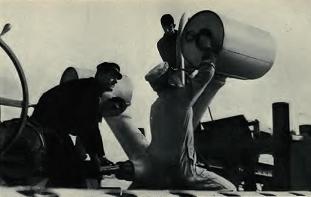 ' '
'Y" gun
The man on the left is loading the "Y" gun
The man on the right is setting a depth charge
|
|
| |
|
|
|
|
| |
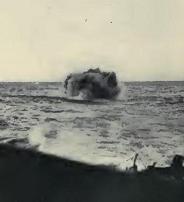
Dropping a depth charge
|
|
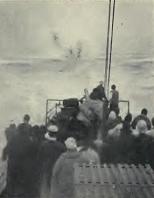
The detonation of a depth charge
|
|
Behind the white tower of the
lighthouse at the entrance to the Gironde a great
arm of the land holds back the sea from the
sheltered roadstead before Le Verdon. To the north
of the entrance the old seaport town of Royan fills
a hollow of the shore, and on the cliff that sweeps
seaward rise the high white villas of a fashionable
summer colony. Two hours run up the muddy river are
the wharves of Trompeloup, where the great naval air
station was established, and where from hog-backed
colliers swinging hard to ebb or flood in the swift
stream, the yachts drew their coal at the end of
every run. Two or three hours farther up the river
were the great docks of Bassin where the stout
freighters discharged their cargoes and where miles
of American tracks and hundreds of American cars
assembled by American mechanics in an American shop
at La Rochelle, received stores innumerable.
Still beyond, within sight of
Bassin, lies Bordeaux, fan-shaped, its broad base
against the stone docks along the south bank of the
river. There were other ports from which and to
which the yachts escorted the merchant convoys; but
in the latter days of the war the bulk of their
convoy work centered in the Gironde. Fifty and a
hundred freighters at a single time rode at anchor
before Le Verdon. Coal-burners and oil-burners;
ships of the lake type, built in states far inland
and launched in fresh water; ships of standard
design in which all sense of elegance or line was
subordinated to the grim necessities of utility,
tramp steamers, fruit steamers, and passenger
vessels that once touched southern ports. Here were
ships from all the Allied world; from the South
American republics; from Italy, Spain, Portugal,
Japan, France, England, Sweden, Norway, Denmark,
Russia. Here were ships flying the tricolor of
France, and most numerous of all were the ships that
flew the flag of the UNITED STATES.
Gray, battered, and still grimy
with coal dust, the yachts dropped down the river
from a wearisome night of coaling at Trompeloup.
Like gray shadows, they passed among the freighters
which, painted in a wild nightmare of camouflage,
seemed like honest and stolid citizens too
consciously arrayed for some fancy carnival.
Slowly, with steam-wreathed bows,
the heavy anchors of the store ships were lifted
from the muddy bottom of the river and they stood
down the channel to the sea, hoists of signal flags
flung from diminutive masts and semaphore signalmen
waving madly from the bridges. Like sheep dogs, the
yachts and the small French patrol boats herded the
convoy consisting usually of from ten to thirty
freighters, " in ballast," to the open sea. Overhead
the seaplanes soared like strange gray flying fish,
too high above their native element, motors snarling
and throbbing on the wind.
There were bright days when the
harbor seemed a gay picture, and there were all too
frequent days of low gray clouds and a heavy green
sea beyond the bar. Then followed long days and
longer nights of uneventful monotony. By day the
convoys followed the zigzag course prescribed by the
escort commander; by night the darkened ships held a
straight course unless a moon and a calm sea
required a continuation of the zigzag.
Clinging to an open bridge in seas
so heavy that they were constantly drenched with
bucketfuls of spray the officers of the escorting
yachts watched their plunging charges wallow in the
sliding seas, now lost to sight behind a cresting
wave, now pitched high against the sky, half-bared
propellers churning the sea. There were interminable
nights of anxiety when the convoy scattered in the
blackness and four thousand-ton freighters were
running wild in a wilder sea; invisible,
ungovernable leviathans, careening far out of their
courses, liable without warning to loom out of the
darkness high above the bridge of a yacht reeling on
the flank or in the rear of the convoy. There too
were nights and days of fog and rain; opaque days
and nights when the convoy became a nightmare. And
there were starlit nights and days of blue skies and
bluer seas. But the days and nights of fog and
darkness held the never-to-be-forgotten hours of
hardship.
All day and night, unremittingly,
the eyes of the watchers strained for a tell-tale
sign of lurking submarine, a slick of oil along the
surface of the sea, a trail of bubbles, a cloud of
birds hovering above cast-up refuse or the fleeting
periscope caught for a second and then lost among
the waves.
Two or three days out at sea the
signals were given and the yachts and French
destroyers abandoned the convoy to the comparative
safety of the open sea and stood off to the
rendezvous where they would intercept the incoming
laden convoy. Then at some hour of night or day the
contact would be made, and several days later the
shores of France would again rise on the eastern
horizon and another convoy with its almost priceless
cargoes would be carried in safety to the shelter of
the harbor.
But better than a description in
general terms of the service performed by the yachts
in the long months of the war may be a brief
recounting of a few instances of the service which
they performed in maintaining intact "the bridge to
France." Spectacular as some of these adventures may
seem, they formed but incidents in a dreary routine,
and it is not exceeding truthful statement to remark
that these engagements and disasters served to
relieve a hardship which otherwise would have been
almost insufferable
At about two o'clock on the morning
of November 5, 1917, the converted yacht Alcedo,
while proceeding on the starboard flank of a convoy,
bound from Brest to Saint-Nazaire, approximately
seventy miles west of Belle-Ile, sighted a submarine
on the surface at a distance of about three hundred
yards on the port bow. The Alcedo turned with full
right-rudder, but was struck by the torpedo on the
port bow and sank almost immediately. One officer
and twenty men were killed or drowned in the
disaster. Due to the suddenness of the attack and
the darkness of the night, the other escorting
vessels were for a time ignorant of the Alcedo's
fate and proceeded with the convoy. Putting off from
the sinking ship in two dories, three officers and
twenty-five men were picked up by fishermen and
towed to the vicinity of Pte. de Penmarch. The
remaining survivors in a whaleboat and two dories
pulled toward Penmarch, and thirteen hours later
were picked up by the French torpedo boat No. 275
and were taken into Brest.
The reports from all concerned
indicate that the action of the officers and crew of
the Alcedo, upheld the finest traditions of the
service. The following letter was received by
Rear-Admiral Wilson, from Vice-Admiral Schwerer,
Commandant Superieur des Petrouilles de L’Ocean de
la Manche he Centrale:
In
the name of the entire personnel of the patrol
squadrons of the Channel, I seek to express to you
the regret which we feel on account of the loss of
that good patrol ship the Alcedo and our brave
comrades who have disappeared with that ship.
They
have joined in the struggle which we are waging
together for the victory of right and humanity and
their deaths will go far toward drawing closer the
bonds which unite our two naval forces.
We
shall cherish their memory and shall strive to
avenge them.
Please
accept my dear Admiral, my sympathy and my most
cordial good wishes.
On the twenty-eighth of November,
19 17, the yachts Kanawha, Noma, and Wakiva were
proceeding with a convoy consisting of the S. S.
Koln and S. S. Medina. The convoy had sailed from
Quiberon in the afternoon and were following the
prescribed zigzag and formation. At 6: 20 P.M. the
lookout on the Kanawha reported a periscope on the
port beam, very close and headed for the Medina. The
Kanawha made the necessary signals, went full speed
ahead and turned left-rudder in the direction of the
submarine. Immediately the submarine submerged,
search by all three vessels of the escort failed to
locate it and signals were accordingly made for the
convoy to reform and proceed. At 6: 50 P.M. the Noma
sighted a periscope on her starboard beam,
apparently steaming to the northward. She
immediately made signal and swung with right-rudder,
at the same time releasing two depth charges. Twelve
minutes later the Wakiva again sighted a periscope,
this time at a distance of not more than a hundred
yards. The submarine drew rapidly aft and was
apparently steaming toward the convoy, but quickly
appeared to swing in order to bring to bear a bow
tube on the Wakiva. The Wakiva turned promptly with
left-rudder, forcing the submarine to cross her
wake, and at the same time fired three shots from
the port aft gun, the third shot apparently striking
the periscope. Shortly after she also released two
depth charges, both of which functioned. A minute
later the conning-tower of the submarine emerged and
the Wakiva opened fire with her starboard forward
gun, the second shot detonating. The conning tower
immediately sank, and as the Wakiva passed over the
spot a large number of air bubbles were seen coming
to the surface, and a quantity of wreckage also
appeared. The Wakiva promptly let go two more depth
charges on the spot, and, turning, again passed near
the spot, when her commanding officer thought he saw
the shapes of three men clinging to a piece of
wreckage and hailed them but received no answer. On
passing near the place a fourth time the men had
disappeared. (Note: this claim is not confirmed
by post-war research.)
Meanwhile the Noma continued her
search and at midnight, sighting a periscope on her
starboard bow, turned toward it and passing over it,
let go a number of depth charges but with no
results.
From the evidence, it appears that
two submarines were preparing to attack the convoy
and that one of these was destroyed by the Wakiva.
This is further confirmed by the fact that about
8:45 P.M. the radio operator on the Noma heard a
vessel sending in German code with low power and
apparently in the immediate vicinity. The vessel
called three times, sending the same message each
time without waiting for a reply. The sea was smooth
throughout the action and the moon was shining dimly
through a slightly overcast sky.
On the twenty-third of December,
1917, the Norwegian S. S. Spro, of about 1,500 tons
gross, loaded with coal, was proceeding from Cardiff
to La Palice. At Brest, she joined a southbound
convoy which was proceeding to Quiberon.
This convoy consisted of five
vessels, the Spro being No. 4. The last ship, a
small French steamer, was well in the rear. The
yachts Sultana and Emeline formed the escort and
were proceeding on either flank of the convoy.
The sea was comparatively smooth
and the moon had risen about one point on the
starboard quarter in a slightly clouded sky.
Suddenly the officer of the deck of the Emeline felt
a pronounced jar passing through the ship, similar
to that caused when a gun is fired from the deck. At
the same instant a black column of water and debris
rose high above the masts of the Spro, In less than
a minute the stern of the Spro sank beneath the
surface of the sea, and in another minute and a half
the vessel entirely disappeared, leaving a mass of
wreckage floating in a heavy oil slick. At the same
time, a dark object was observed about a hundred
yards beyond the Emeline, to port of the column and
to windward, and a pronounced odor of exhaust gases
was perceptible on the breeze. The Emeline headed
directly for the object but it quickly disappeared.
A boat was then launched in answer to the cries of
the men swimming in the water, and the Emeline
circled about the spot where the Spro had gone down.
Eight men cleared the ship, one of whom was not
recovered.
On the fifth of January, 1918, a
convoy of fifteen ships left Brest for Quiberon,
escorted by two American yachts, the Wanderer and
the Kanawha. The convoy was formed in two parts, the
S. S. Luckenbach being No. 1 in the right column.
The S. S. Le Cour, S. S. Dagny and S. S. Kanaris
being Nos. 1, 4, and 7 respectively in the left
column. At about 11:30 A.M. when approximately eight
miles west of Penmarch, the lookout at the port
cathead of the Le Cour saw a torpedo jump out of the
water. A second later the torpedo struck the ship
abreast No. 4 hatch and the Le Cour sank in
forty-five seconds. Half an hour later, a torpedo
struck the Luckenbach, the force of the explosion
throwing several men into the sea. The Wanderer
which was nearest by saved twenty-five members of
the crew and remained in the vicinity for several
hours, but no trace of the submarine could be found.
At a quarter past one in the morning the captain of
the Dagny sighted a submarine to the starboard. He
immediately began to zigzag, blew his whistle and
fired two lights to attract attention. Ten minutes
later the ship was struck on the starboard side and
sank in about two minutes. At two o'clock the guns'
crew on watch on the stern gun of the Kanaris saw
the wake of a torpedo about 45° to starboard. The
Kanaris was struck on the starboard bow and sank
rapidly.
The following letter was received
by Lieutenant-Commander P. L. Wilson, commanding
officer of the Wanderer:
From:
Commander U. S. Naval Forces in France. To:
Commanding Officer, U. S. S. Wanderer.
SUBJECT:
Officers and men U. S. S. Wanderer, manner of
performance.
The
Commander U. S. Naval Forces in France
congratulates the Commanding Officer U. S. S.
Wanderer for the able manner in which the officers
and men under his command performed their duty
under very trying circumstances in the presence of
the enemy, upon the occasion of the sinking of the
S. S. Harry Luckenbach, sunk by enemy submarines
on the night of January 5-6, 1918.
(Signed)
H. B. Wilson.
About a mile east of Pte. du Talut
is a low-lying reef which offers a constant danger
to navigation. On the twenty-seventh of January,
1918, a dense fog covered the water. The Guinevere
was returning from Quiberon, and was proceeding at a
speed of about nine knots, with the commanding
officer and a French pilot on the bridge, when she
suddenly struck the reef tearing her bottom so badly
that within two hours her deck was under water and
the high swells were causing her to pound heavily on
the reef, threatening her complete destruction. The
ship was accordingly abandoned, as it was seen that
the case was hopeless, and later investigation
proved the impossibility of salvaging her. Today a
torn hull lies in French waters, a mute reminder of
the activities of an American pleasure yacht in her
strange mission of war.
On May 21, 1918, the Christabel
sighted a periscope on the starboard beam at a
distance of about three hundred yards. The crew
immediately went to “general quarters" and a number
of depth charges were dropped, set at a depth of
seventy feet. Following the explosion of the second
charge there was a violent third explosion which
sent up an enormous quantity of water. This
explosion was distinct from the usual double shock
felt when the explosive force of a depth charge
reaches the surface. Immediately afterward the
Christabel crossed over the spot and found the
surface for an area of a hundred feet in diameter
covered with large air bubbles, much heavy black oil
and quantities of splintered pieces of wood,
evidence of the destruction of another enemy
submarine. (Note: this claim is not
confirmed by post-war research.)
The third of the yachts to meet her
fate was the Wakiva. On May 22, 19 18, she was
proceeding with a Le Verdon convoy. A heavy fog
covered the sea, and due to a confusion of signals
resulting from the poor visibility, the S. S. Wabash
made an unexpected change in course and rammed the
Wakiva. The yacht sank rapidly and the Wakiva’s
officers and crew were picked up by the Wabash,
which vessel returned with them under escort of the
Isabel to Quiberon.
| |
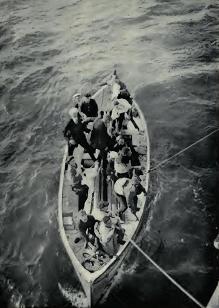
|
|
Picking
up
a lifeboat in the Bay of Biscay
|
|
| |
|
|
|
|
| |
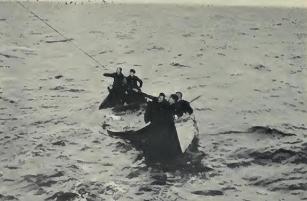
Picking
up a lifeboat from a torpedoed ship - four dead
men were in the partly swamped boat
|
|
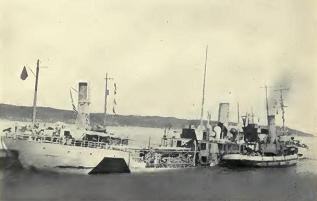
The
Westward Ho being towed into Brest with only
one per cent floatability
|
|
On the same day while escorting a
northbound coastal convoy, the Christabel detected a
wake about three hundred yards from the convoy and
running parallel to it. The Christabel promptly
steamed across the wake dropping a number of depth
charges. About three hours later a submarine
appeared near the convoy and the Christabel again
steamed toward it, and as the submarine promptly
submerged, crossed over the spot and dropped two
more depth charges, both charges functioning. The
first charge brought up only clear water, but the
second brought up heavy oil bubbles and parts of
heavy wood and debris. Following the second depth
charge, an explosion was detected beneath the
surface, which was doubtlessly a mine or torpedo in
the submarine detonated by the concussion of the
second depth charge. (Note: this claim is not
confirmed by post-war research.)
The U. S. S. A. C. T. Westward Ho,
when about three hundred miles off the French coast
on the eighth of August, was torpedoed. Replying
promptly to an “Allo" the destroyers Conner, Roe,
and Ericsson, started to the rescue and reaching her
in a few hours, took off surviving members of the
crew. The Westward Ho was apparently in a sinking
condition and as the destroyers had to proceed on
their duties as convoy escorts she was abandoned.
The Westward Ho, however, remained afloat during the
night and at four o'clock the following morning was
discovered by the yacht Noma. After investigating
her condition the Noma put a salvage crew on board,
and a little later the yacht May and the French
torpedo boat Cassioppee having come up, the Westward
Ho was taken in tow. Due to the fact that she was
apparently sinking by the head she was taken in tow
stern first by the two yachts and the torpedo boat
and a start was made for the French coast. At about
2 P.M. the British tugs Epic and Woonda joined up
and relieved the yachts and torpedo boats. Due
primarily to the efforts and ingenuity of the
engineer officer of the Noma, steam was started in
the boilers of the Westward Ho, and at 4 P.M. with
reversed engines she was started backing at good
speed. At six o'clock on the morning of August 10,
the Concord and the French torpedo boat Glaive
joined up and the Concord passed a third tow line.
In this manner the convoy proceeded to Brest where
they arrived at six o'clock on the evening of August
11, a distance of 315 miles. The cargo of the
Westward Ho was extremely valuable and of an
important character, and her salvage under these
most extraordinary conditions reflected great credit
on all of the rescuing ships concerned. The cargo
consisted chiefly of aeroplanes, field artillery
parts, rifles, machine guns, ammunition, and large
quantities of grain and hay.
In forwarding the officers' reports
concerning the salvage of the Westward Ho, the
Commander United States Naval Forces in France
commented in part as follows:
No
criticism is made of the master of the Westward Ho
for having abandoned his vessel, inasmuch as her
condition was believed to be desperate and the
destroyers which rescued her crew were required
for duty with troop transports and could not
remain in the vicinity.
The
salvage of the vessel was a splendid feat of
seamanship.
The
party from the U. S. S. May and U. S. S. Noma,
under the direction of Lieutenant Thomas Blau, U.
S. N. R. F., boarded the vessel, raised steam,
pumped compartments adjacent to No. 1 hold and
started the ship's propelling plant. The vessel
was taken in tow by the U. S. S. May and
Cassioppee and subsequently by tugs which had been
dispatched from Scilly Islands and from Brest.
With the assistance of her engines she was towed
stern first for a distance of 315 miles.
It
is recommended that the Navy Department address
letters of commendation to the following officers,
who participated in this enterprise:
Lieutenant-Commander
C. C. Windsor, U. S. N., commanding U. S. S. May,
(Senior officer present);
Lieutenant
H. H. J. Benson, U. S. N. commanding U. S. S.
Noma;
Lieutenant
Thomas Blau, U. S. N. R. F., and
Lieutenant
(j. g.) W. R. Knight, U. S. N. R. F., who took
charge of the machinery part of the vessel.
Another aspect of the hardships
encountered by the yachts in their convoy service
may be taken from the log of a single trip of the
Noma. While proceeding to a rendezvous she
encountered a severe northerly blow and the seas
which were unusually short made it difficult for the
yacht to take them with ease. She proceeded to the
rendezvous, however, when she slowed down, and soon
after, a heavy sea on her bow smashed in the forward
skylight, causing a considerable amount of water to
leak through to the lower deck. The same sea also
caused the forward deck houses to work considerably.
An hour later while running with the sea abeam, at a
speed of about five knots in search for the convoy
another heavy sea struck the starboard side denting
it and bending four frames; the same sea carried
away a davit and part of the gunwale. Returning to
port, having met the convoy, the Noma began to roll
deeply, the sea being abaft the port beam, and the
second lifeboat's strongback was carried away. By
this time the entire main deck had begun to work and
the deck below the main deck was wet from stem to
stern, officers' rooms and the crew's living
quarters were thoroughly drenched and all of the
bedding was wet.
It was hard work; long were the
hours and brief the respite. Little has been told of
the merchant convoys, for theirs was a work that
required secrecy of movements, and secrecy shrouded
the wearisome voyages. Only at rare intervals was
the story of some sinking told by the crowded press.
But for the most part the incidents of their story
were incidents of negative action rather than of
active deed. Armed with the dreaded depth charges
the yachts reduced the submarine warfare against our
merchant shipping to a degree that rendered its
effect negligible in comparison with the vast
operations which were carried through. In the
coastwise convoys there were more frequent losses,
but here a smaller individual tonnage offset the
losses incurred. Without exaggeration it may be
truly said that had it not been for the yachts and
the few destroyers which aided them in the escort
duty of the store ships, the German scheme of
submarine warfare would have succeeded to a degree
that would have rendered impossible the maintenance
for a single week of our Army on the soil of France.
And at the same time it must be added, that without
the destroyers, and in the earlier days of the war
the yachts as well, the activities of the German
submarines would have rendered wholly impossible the
transportation of our Army across the sea.
CHAPTER
V
THE
DESTROYERS
In the first days of the United
States naval activities in French waters, it will be
recalled that the duty of escorting both troop and
store ships fell to the converted yachts. With the
advent of the destroyers, the system was altered;
and, as the number of destroyers was increased, the
yachts were gradually withdrawn from the troop
convoys and detailed to the more southern ports to
act as escorts to coastwise convoys and to the great
transatlantic convoys of store ships which centered
at the Gironde River. Later, as the destroyer fleet
was materially augmented, a number of smaller
coal-burning torpedo boats were assigned to duty
with the yachts, considerably strengthening their
force and compensating for the yachts which had been
lost or from their months of hard service had so
deteriorated that their usefulness was seriously
impaired.
The destroyers were ideally suited
for the important work of escorting the troop
convoys. Possessing the invaluable qualities of high
speed, practical armament, and seaworthiness, they
were able to cope with every emergency and meet the
submarine on a basis on which the result was certain
to terminate, in the large majority of instances, in
their favor.
Within the breakwater, which
shelters the inner harbor of Brest, the destroyers
swung from buoys, moored together in clusters, great
rafts of slender steel hulls above which lifted a
tangle of slim masts and wireless antenna. Painted
in fantastic camouflage and swarming with crews
which averaged more than a hundred men, the
destroyer flotilla that was based in the busy harbor
afforded a constant picture of absorbing interest
and vitality.
A convoy is to leave at 2 P.M. and
the Benham casts off from the destroyers lying on
either side of her and backs swiftly out into the
open water. Sensitive and alert, she turns sharply,
as her engines shoot her ahead, and with a white
curve of water, knifed up on either side of her
chisel bow, she steams rapidly through the narrow
entrance. In the wide reaches of the outer harbor, a
convoy of camouflaged liners are lifting their
anchors, homeward bound. Slowly they stand down the
channel between the cliffs, the Benham and the other
destroyers of the escort loafing leisurely beside
them. Outside, standard speed is set and the convoy
heads for the open sea.
| |
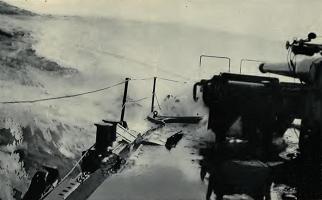
Rough
weather on the destroyer Benham
|
|
| |
|
|
|
|
| |
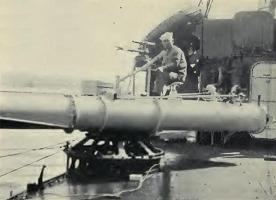
Torpedo tubes on destroyer Benham
|
|
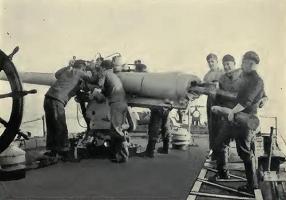
Four-inch
gun crew on destroyer Benham
|
|
There is no motion on land or sea
comparable to that of a destroyer. Rolling often in
five-second jerks at an angle sometimes over 50°,
there is combined with the roll, a quick and violent
pitching which produces a sensation without parallel
on any other type of vessel. To those familiar with
the great buildings in our larger cities, this
pitching movement of a destroyer may be compared
with the abrupt starting and stopping of an elevator
operating at high speed; a sudden sinking, in which
the deck seems to drop away beneath the feet and
then an abrupt upheaving motion, almost before
equilibrium can be regained.
Like maddened switchback cars, the
destroyers gyrate in the slightest sea. Grimy with
soot of fuel oil, reeking with oil gasses, they reel
and plunge at express-train speed. The officers and
men on the bridge, half choked with frequent back
drafts of gaseous oil smoke, and the reek from the
"Charley Noble" (galley smokestack), peer ahead
through a blizzard of flying spray. In the wardroom,
the colored mess attendants balance like acrobats
and with the expertness of long experience, perform
almost impossible feats of juggling with plates and
glasses. Few are the days when meals can be served
even with racks on the tables. It is a hand to mouth
existence, a catch-as-catch-can game in which the
galley challenges the sea and the sea usually holds
the cards. Even personal cleanliness becomes
impossible in an unstable world, where water will
invariably find its level when the wash bowl slants
at 45° or 50°. Chairs are lashed to the bulkheads,
and by night or day, when opportunity offers,
officers and men roll into troubled bunks fully
dressed, ready at a moment's notice to appear on
deck.
Within the three-eighths-inch steel
hull, the great turbines, with the horsepower of a
battleship, throb and spin, driving the whirling
screws. There is not a foot of wasted space. In a
swinging and bucking world, crammed like a watch
case with a maze of machinery, the engineering crew
moves like magicians in a world of steel and steam.
Everything is steel. Everywhere is the smell of oil;
the ship is greased with it. And day and night,
rolling, pitching, slamming over, through or under
the heavy seas, the destroyers brought in the
convoys, meeting them on some square mile of
Atlantic, in the reek of fog or the blackness of
night, with unerring mathematical precision.
There was a strange emotion that
came to more than a few of our sea-borne soldiers
when from some high deck on a stormy morning, they
first saw the destroyer escort shaking the great
green seas in clouds of spray from their swaying
bows. On these sea-whippets lived men in dungarees
and rubber boots who met the sea and mastered it;
men who lived in oil and spray, continuously
balanced in a mad unstable world, and of greatest
importance in the eyes of the men who watched from
the transport's decks, was the protective part in
the great game of war that the destroyer stood ready
day and night to play. To cast loose the depth
charges, to man the guns, to ram the submarine if
possible; these were the ultimate purposes of the
destroyer escort. And so thoroughly did they perform
their untiring service that our army was carried in
its vast entirety to its mission beyond the seas and
landed safely on the soil of France. In this
anti-submarine warfare the depth charges proved to
be the most efficient deterrent to submarine
activity. In appearance a cylinder about two feet in
diameter and about three feet in height, each charge
contained three hundred pounds of high explosive and
a hydrostatic apparatus by which the explosive was
detonated which could be set for any depth from 50
to 250 feet, the force of the explosion over an area
of 140 feet in diameter being sufficient to destroy
the submarine or force it, injured, to come to the
surface. On sighting a submarine, or locating it by
any of the tell-tale indications of its presence,
such as oil slicks, or a wake of bubbles, the
practice was immediately to drop a buoy, marking the
spot and then to proceed on a widening circle from
this point, dropping a barrage of depth charges in
rapid succession covering the entire area ahead,
behind and on either side of the submarine, thus
anticipating its movements of escape in any
direction.
But there is no general description
of the work of the destroyers that can briefly
convey an impression of their labors so well as a
few specific incidents of the anti-submarine warfare
waged by them in the historic waters of the French
coast during the long months of war. It is
impossible to recount all the engagements which
occurred; it is even more impossible to describe the
long periods when no break relieved the grind of
routine duty at sea. Day and night, month after
month, they kept their flags flying. Their whole
story, which may some day be told, is a narrative of
arduous duty conscientiously performed.
On August 9, 1918, the Tucker,
while leading a column of ten destroyers, sighted a
periscope on her port bow at a distance of eight
hundred yards and gave chase. The submarine dived
and the Tucker, going ahead at full speed, dropped
two depth charges about two hundred yards beyond the
point of submergence. She then dropped fourteen
charges in a circle, when the bow of the submarine
broached and the Tucker opened fire with four
blunt-nosed shells, two of which scored hits. The
submarine then submerged and the Tucker passed
directly over the spot, sighting her at a depth of
twenty feet and dropped two charges directly on her.
A few minutes later oil appeared on the surface of
the water and it was believed, with reason, that the
submarine was destroyed. (Note: this claim is
not confirmed by post-war research.)
On the twenty-fourth of April,
1918, a southbound coastal convoy was proceeding
slowly off Penmarch with the Stewart acting as
escort. About two miles to seaward of the convoy's
position, two American naval avions were seen
dropping bombs. The Stewart immediately left the
escort and proceeded at full speed to the spot
indicated by the avions, where she was joined by a
French destroyer coming from the northward.
One avion heading directly toward
the Stewart, dropped a buoy and the observer pointed
with his arm in the direction of the submarine. The
sea was smooth, with a slight swell and a clear and
distinct wake could be seen, with an object just
breaking the surface at the end of the wake. The
Stewart headed directly for the object and followed
it to seaward, but the wake suddenly changed its
direction as the object turned at right-angles to
its original course. One of the avions promptly
circled and dropped a smoke bomb near the new
position of the object which had now submerged but
was still visible in the clear water from the bridge
of the Stewart. The Stewart passed within fifty feet
and dropped two depth charges in rapid succession
each one bringing up a column of water darkened with
a heavy oil which spread rapidly over the surface.
For a time after the explosion, the water in the
vicinity was streaked with a thick red substance,
the nature of which could not be determined. The
depth charges were dropped so close to the
submarine, one on each side and within fifty feet of
it and the force of the explosion was so great that
it seems impossible that the submarine could have
survived. (Note: this claim is not confirmed by
post-war research)
One of the many instances of timely
interference of an American destroyer, which by its
presence undoubtedly saved an attacked ship,
occurred on the nineteenth of October, 19 17. The
American steamer J. L. Luckenbach was about two
hundred miles west of Brest when the lookout sighted
a suspicious ship about five miles on the port beam
and the captain immediately changed his course to
put the supposed enemy astern. At a distance of
about eleven hundred meters the ship, which soon
proved to be a submarine, opened fire, keeping,
however, well out of reach of the Luckenbach’s guns.
For a considerable period heavy firing was
maintained by both vessels, the submarine
endeavoring by her fire to keep the Luckenbach at a
distance and to maneuver herself into a position
from which she might fire a torpedo. Meanwhile the
Luckenbach attempted to prevent the submarine taking
this action. About two hundred shells were fired by
each ship, seven of the enemy's striking the
Luckenbach, At the beginning of the encouater. the
Luckenbach sent an "Allo" by radio which was picked
up by the American destroyer Nicholson (then
attached to the United States squadron based at
Queenstown), who responded that she was on her way.
About the middle of the engagement, the Nicholson
sent a new signal saying, "I am coming; make all
possible smoke to make yourself visible." Shortly
after, a shell struck the mount of the after gun of
the Luckenbach forcing the captain to turn the ship
to the left in order to use his forward gun. At the
end of two hours' engagement, a shell from the
submarine struck the Luckenbach, damaging the
engines, cutting the smokestack and forcing the
vessel to stop. But an hour later, the Nicholson
appeared over the horizon and as she neared, fired
four shots at the submarine which submerged and
disappeared. After temporary repairs, the Luckenbach
continued her way and reached Le Havre, leaking
badly and with a fire in the crew's quarters.
At 9:45 A.M. on the thirty-first of
May, 1918, the U. S. S. President Lincoln was
torpedoed and sunk. On the first intimation of
disaster, calls were sent out to the destroyers who
proceeded promptly to the rescue of the survivors,
the Warrington being the first one to arrive,
reaching the spot at 11.05 A.M. Shortly after, the,
Smith appeared above the horizon and joined the
Warrington, There were twelve boat loads of
survivors and a number of life rafts.
A moderate swell was running but no
difficulty was experienced in effecting the rescue.
The officers and men of both the Warrington and
Smith showed great devotion to duty and initiative
in handling a very difficult and unusual situation,
particularly in rescuing the men off the life rafts
and received a letter of commendation from the
Commander United States Naval Forces in France. In
all, 685 Navy and Army officers and enlisted men
were rescued. Four naval officers and twenty-three
naval enlisted men were counted missing. Of these,
one officer. Lieutenant E. V. M. Isaacs, U. S. N.,
was taken on board the submarine and later escaped
from a German prison camp. (Note: Lt Isaacs was
subsequently awarded the Medal of Honor)
| |
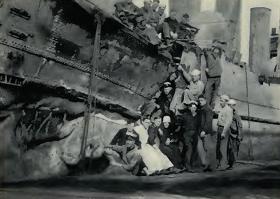
Where
the destroyer Jarvis rammed the
destroyer Benham
|
|
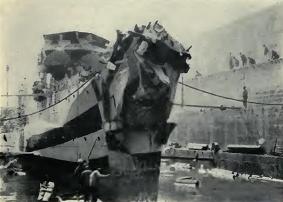
The
bow of the Jarvis after her collision with the
Benham
|
|
| |
|
|
|
|
| |
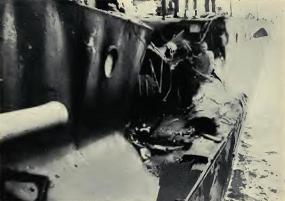
The
side of the Benham after being rammed
by the Jarvis
|
|
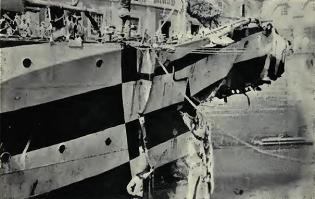
Bow
of the destroyer Jarvis after collision
with the Benham
|
|
On the first of July, 1918, at a
quarter after nine in the evening, the U. S, S.
Covington which had left Brest for the United States
on the morning of the same day, was torpedoed in
latitude 47° 24' N. longitude 7° 44' W., by a
submarine which was not seen before or after the
attack. Prior to the explosion, however, the wake of
a torpedo was seen by the executive officer, close
to the ship. When struck, the Covington was
zigzagging in the front line of an eight-ship
convoy, escorted by seven destroyers. The blow was a
quartering shot, just forward of the engine-room
bulkhead, in No. 5 bunker on the port side. The
bulkhead was damaged and the engine-rooms and
fire-rooms were rapidly flooded. The ship took a
strong list to port, but stayed afloat until 3:32
P.M. of July 2, 1918, when she sank very rapidly in
the final plunge. Immediately after the torpedo
struck, the U. S. S. Smith opened a depth-charge
barrage and circled the Covington. Meanwhile, as the
torpedoed ship was helpless and liable to be hit
again, she was abandoned by the officers and crew in
excellent order and all the known survivors were
taken on board the Smith. At daylight the captain
and officers and twenty-two men, together with one
officer and eight men of the U. S. S. Reid, which
had arrived on the scene, returned to the Covington
to supervise salvage operations. The Smith was later
joined by the Wadsworth, Shaw, and Nicholson and the
French gunboats Conquerante and Engageante. At five
in the morning of July 2, 1918, the Covington was
taken in tow by the U. S. S. tug Concord and the
British tugs Revenger and Woonda, but the gradual
sinking of the ship finally made progress impossible
and after towing her approximately twenty-five
miles, the ship was abandoned by her salvage crew
and sank in twenty minutes after the last man was
taken off. The Smith, with 743 survivors, proceeded
to Brest; and the Nicholson with the captain of the
Covington and the salvage crew, arrived at the same
port a few hours later. Of the entire crew of the
Covington, only three were unaccounted for and three
were drowned. The discipline and courage of all of
the officers and crew of the Covington were
excellent and crews of the fire-room and engine-room
on watch at the time, showed particular fortitude.
Illustrative of the dangers of
navigation, when navigating without lights and in
crowded waters, was the collision of the destroyers
Benham and Jarvis. The night was very dark and there
was a heavy fog. Both vessels were making high
speed. Suddenly the rudder of the Jarvis jammed, she
sheered quickly toward the Benham and overrode her
abreast of the bridge, tearing a great hole in her
side extending half way through the wardroom. The
force of the blow tore away the bow of the Jarvis
almost completely. Fortunately, the injuries to the
Benham were largely above wind and water and the
collision bulkhead of the Jarvis held sufficiently
to permit her to follow the Benham to Brest.
Many were the instances of
engagements between destroyers and submarines in
which the final outcome remains unknown. In a large
number of instances, however, it is highly probable
to presume that the submarine made a successful
escape; but there were also many times when the
prompt action of the destroyers must have proved
fatal to the submarine, although no tangible
evidence of its fate appeared. (Note:
regrettably, none of these claims are confirmed by
post-war research)
In a smooth sea, with the sky
partly overcast and a new moon low in the sky, the
destroyer Cummings sighted what appeared to be the
wake of a torpedo crossing about fifty yards ahead
of her bow. The rudder was put "hard-left;” the crew
sent to "general quarters" and the Cummings shot
forward at full speed and followed the wake which
was very straight and unbroken, and marked with a
wake of bubbles when first sighted. As the Cummings
advanced, dense smears of oil were perceived on the
surface, terminating at a distance of three hundred
yards in a large slick. A barrage of twenty depth
charges at ten-second intervals was dropped and the
destroyer circled in the vicinity for half an hour,
but no evidence of the submarine appeared.
Another instance comes from the
Benham. On the morning of July 9, the junior officer
of the deck sighted a periscope on the starboard bow
of one of the ships of the convoy. Steaming at full
speed, depth charges were dropped several hundred
yards before the spot was reached, in order to check
the submarine and prevent her firing her torpedoes.
The destroyer then circled and dropped a barrage of
depth charges, but no wake, oil slick, or other
disturbances were seen on the water.
Another story of a submarine comes
from the Reid, which was proceeding with a
west-bound convoy on July 17. The Nicholson, which
also was with the escort, was seen shelling an
object to the northward and the Reid promptly
proceeded toward the point of fire, where what
appeared to be the wash of a moving periscope was
visible. When about a mile from the point and
fifteen hundred yards from the Nicholson, the Reid
saw an object break water on her port bow with a
perceptible white wash and splash and a minute later
the officers on the bridge saw a torpedo headed in
her direction and toward the convoy. The Reid
immediately began to drop depth charges to deflect,
or if possible, destroy the torpedo, which was
proceeding, at times broaching bright in the
sunlight, at a high speed. After about ten minutes,
a wake was sighted and a number of depth charges
were dropped. The depth charge next to the last one
appeared to counter-mine and exploded what was
thought at the time, to be another charge which
might have been let go at approximately the same
time. This second explosion was near the surface and
caused a heavy dull shock and concussion over a wide
area. Later, it was found that two charges had not
been let go simultaneously and it was therefore
presumed that the dull shock was caused by an
explosion within the submarine.
The two words, "suspicious object,"
appeared frequently in the reports of the
destroyers, for whenever a suspicious object was
sighted, action by the destroyers invariably
followed. During one of the summer months of 1918,
the McDougal sighted a dark slate-colored object
like a low mound, at a distance of about seven
miles. She proceeded immediately at a speed of about
thirty knots toward the object, which began to move
in a northwesterly direction. The crew were sent to
"general quarters," manning the guns and torpedo
tubes, depth-charge throwers and releases. By this
time the object showed a second low hump about sixty
feet to the left, but no periscope, gun, or deck
line was visible and a few minutes later the object
disappeared. Heading for the spot, two depth charges
were dropped on a slight oil slick which appeared,
but there were no other indications of the presence
of a submarine.
At about sunrise on the morning of
the fifth of October, while standing into the harbor
at Brest, a torpedo was sighted by the Bridgeport
about one hundred and twenty-five yards from the
ship, running so close to the surface that its whole
outline could be seen. It was at first thought that
the torpedo would strike the ship in the vicinity of
the mainmast, but it finally passed clear of the
rudder and so close, that it was seen by a number of
people looking over the fantail. Upon sighting the
torpedo, the speed of the Bridgeport was increased
and the rudder swung "hard-left," which prompt
action undoubtedly saved the ship.
The Fanning which was escorting the
Bridgeport, immediately dashed through the convoy at
a speed of twenty-two knots and headed in the
direction from which the torpedo was fired,
searching for traces of oil. A small patch of oil
was finally discovered and six depth charges were
dropped at ten-second intervals. On sighting some
more oil ahead, the Fanning dropped a number of
additional depth charges, and then perceiving a
heavy oil wake about a thousand yards ahead,
followed it at full speed. Approaching the slick, a
clearly marked zigzag was perceptible, as if the
submarine were going deeper and slowing down. The
oil was heavy and a strong oily smell was
noticeable. More depth charges were dropped and the
search was continued for a number of hours but no
further indications of the presence of a submarine
appeared.
It is now believed that the
submarine which attacked the Bridgeport was later
sunk by a French patrol boat with a three-hundred
pound American depth charge in a position about
seven miles north of Ile de Sein, in about thirty
fathoms of water. The patrol boat sighted the
periscope of the submarine at a considerable
distance on the bow and passing over the spot where
the submarine submerged, dropped depth charges. The
listening apparatus established the fact that the
submarine remained on the bottom and additional
depth charges which were released produced a heavy
persistent oil patch. The patrol boat remained in
the vicinity all night and the submarine was not
heard to move. (Note: this claim is not
confirmed by post-war research. However USS
Fanning was responsible for what is believed to be
the one success by US forces in World War 1 –the
sinking of U.58 off the Bristol Channel on the 17
November 1917. )
| |
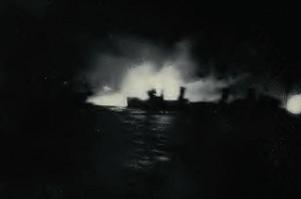
The
explosion of the Florence H
|
|
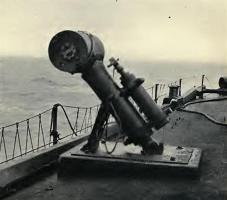
Thornycroft depth-charge thrower
|
|
There is another story in the
following extract from the diary of the flotilla, a
simple statement ungarnished by details, of a trip
that is probably not yet forgotten by those who
participated in its stormy adventures:
The Roe, Monaghan, and Warrington
returned from danger zone escort duty with troop and
store ships, having weathered the gale of the past
few days. The Monaghan lost her foremast and the Roe
her mainmast. Both vessels lost boats. The
Warrington lost her liferafts.
Such was the weather off Finistere
on the nineteenth of December, 1917.
The story of American naval
activities in French waters is relatively free from
those disasters which seem an almost certain part of
any great activity, and the single grave disaster,
the burning of the Florence H. gives emphasis to our
great good fortune in this respect, in spite of the
constant dangers, other than those of the submarine,
to which our ships were constantly subjected while
in port; dangers due primarily to the vast
quantities of high explosives and inflammable stores
with which they were loaded. The Florence H. was
anchored in convoy at Quiberon Bay on the
seventeenth of April, 1918. At a quarter to eleven
in the evening, a violent explosion on board wrecked
the vessel. The cause has never been determined, but
as she was loaded with powder and there is little
likelihood that a submarine could have penetrated
into Quiberon Bay it seems plausible that the
explosion was internal.
The Florence H. had been at anchor
about half an hour when the explosion occurred. At
the moment of the disaster the destroyer Stewart was
passing at high speed. From the description later
made by the Stewart's commanding officer, the
Florence H. burst suddenly into flame, like a flare
of flashlight powder. At intervals the flame died
down sufficiently to permit the outline of the ship
to be clearly visible, then suddenly, the
incandescent glare increased again until nothing
could be seen but a mass of flame rising from the
water. In about five minutes the forward part of the
ship began to break up and at rapid intervals loud
explosions of ammunition occurred. Then the sides of
the vessel fell outward and the surrounding water
was strewn with burning boxes of powder. The Stewart
turned from her course and headed in toward the
after section of the Florence H. which had still
held together, with the hope of rescuing the
survivors of the crew. In addition to the Stewart,
the destroyers Whipple and Truxton and the yachts
Wanderer, Christabel, Sultana, Emeline, Corona, and
Rambler, aided in the rescue; and gallant work was
performed by the rescuing parties who proceeded in
small boats from the various ships as close as
possible to the burning ship. Of seventy-five people
on board the Florence H. at the time, thirty-four
were rescued, although many of the survivors were
severely burned.
In a very few minutes after the
fire had broken out, great masses of burning
wreckage spread over the sea to the leeward and
burst into sudden flame as the ammunition and powder
cases exploded, shooting long tongues of fire and
bursts of gasses into the air with a roar which rose
above the sound of the burning ship. But the rescue
parties from the various ships pushed fearlessly
into the burning mass of wreckage, ignoring the
powder cases which were constantly exploding around
them, and by their prompt work were responsible for
the saving of the survivors.
On May 3, Vice-Admiral Moreau,
prefet maritime of Brest, boarded the U. S. S.
Stewart and with the crew drawn up for muster pinned
on Lieutenant H. S. Haislip, the commanding officer
of the Stewart the croix de guerre for his splendid
work in rescuing the survivors of the S. S. Florence
H. under very dangerous circumstances at the time of
her destruction. Admiral Moreau then addressed the
ship's company and complimented them in the warmest
terms on the fine work which they had accomplished.
And on September 26, 1918, a second
interesting ceremony took place on board the
Stewart, in the harbor of Brest, when Frank Upton,
quartermaster, third class, U. S. N. and Jesse W.
Covington, ships cook, third class, U. S. N., were
decorated with the Congressional Medal of Honor for
their heroic action in jumping overboard and saving
the wounded from the Florence H. at the time of her
explosion and destruction by fire. In presenting
these medals, the Commander United States Naval
Forces in France, said in part:
While the department has designated
these two men, the honors were not limited to these;
for the whole ship's company, with their ship, have
all consistently distinguished themselves.
CHAPTER
VI
OTHER
ACTIVITIES
THE chief work of the Navy in
France was naturally to patrol the sea and to wage
an anti-submarine warfare; but there were also other
activities of the naval forces which should be
included in an account of its work abroad during the
war. Books could, and doubtless will be written
covering fully these activities, and it is with
reluctance that only such brief mention can be given
here. But at least this slight narrative may give
some intimation of the constant dangers and
hardships in which the officers and enlisted men of
our naval forces in France participated.
For centuries the surface of the
sea has alone afforded the setting for naval
activities; but with the entrance of the hydroplane
and the dirigible balloon into modern warfare
strange tales of new adventures and achievements in
another element have been written into the annals of
the sea.
But as the purpose of this
narrative is to deal primarily with the activities
of the men who went down to the sea in ships, and as
by the close of the war the naval air establishment
had reached a size and scope which would require an
entire volume adequately to describe, it seems
advisable to give here only a brief resume of this
important work and a few graphic instances of naval
cooperation on the sea and in the air.
The aviation forces of the United
States Navy in France made its first establishment
on the French coast under the general command of the
Commander United States Naval Forces in France, with
Captain Hutch I. Cone in immediate command.
Organized originally to comprise three air stations
situated at Dunkirk and at the entrances to the
rivers Loire and Gironde, the number was constantly
increased until at the close of the war a continuous
fringe of United States and French naval air
stations for hydroplanes and dirigibles lined the
coast from Dunkirk to the Spanish boundary. Due to
the fact that the French aviators and planes were in
a large measure withdrawn from the coastal work in
the earlier months of the war for land service on
the German lines, the arrival of the American forces
afforded an invaluable and greatly to be desired
assistance at a time when the immeasurably increased
coastal and deep-sea traffic due to the entrance of
the United States into the war created a
proportionate increase of submarine activity.
By the close of the war the entire
coast was included in a comparatively complete
system of air patrols, and plans were nearing
completion for a series of fifty American and French
stations to control intensively the entire seacoast.
At the beginning, the work of the
American forces was purely of reconnaissance, and
the convoy patrols were carried on entirely by the
French avions from their bases at the larger ports.
Later, a proportion of the convoy work was
undertaken by the American aviators and three
kite-balloon stations were established at Brest,
Lorient, and La Trinite.
| |
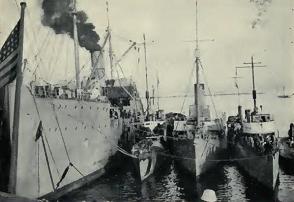
Destroyers alongside the Bridgeport at Brest
|
|
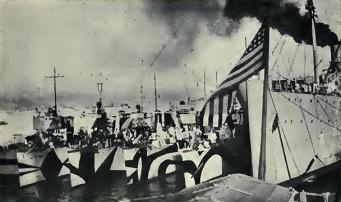
Another
view
of the destroyers showing camouflage
|
|
| |
|
|
|
|
| |
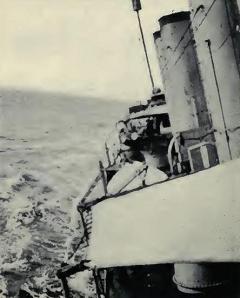
Looking
forward on a “flush deck” destroyer
|
|
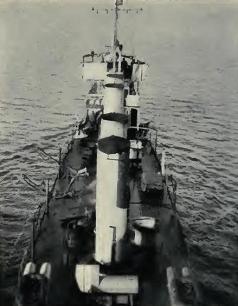
Looking
aft on a “flush deck” destroyer
|
|
The value of the hydroplane and the
dirigible in naval warfare cannot be overestimated.
Possessing a high speed, a wide range of operation,
a relative safety from attack and operating at an
altitude from which observation over a vast area is
possible, the aviator is now able to direct the
movements of fleets and guide their operations
against an enemy invisible from the level of the
sea. As the swift frigate was to Nelson and the
cruiser to Togo, so to the admirals of the present
war the hydroplane has made possible a knowledge of
enemy operations far in advance of the actual
contact, and as sea power in past ages has been the
key to national security, so in the future years
must sea power be assured by air supremacy.
As an enemy of the submarine the
sky frigates have, in the war immediately past,
proved of the greatest value, for from the plane of
their operations it was possible to scan a wide
tract of sea, and even in the depths of the water to
detect the presence of the submerged submarine.
Armed with bombs and machine guns they were not
limited to the work of scouting, but under varied
circumstances in a large number of in stances gave
battle to the enemy and rendered an invaluable
service.
The comprehensive operations of the
United States Naval Air Force in France required an
amount of construction which had only reached
completion shortly before the termination of
hostilities. Had the war continued for even a few
months longer this branch of the service would have
played an enormously greater part in the conflict
with the submarine. As it was, the service rendered
was of a vital nature and the entire organization is
entitled to much commendation for the work actually
done and the comprehensive plan which was brought so
nearly into full operation.
The following instances have been
selected as characteristic of the work performed by
the aviation forces in conjunction with the Navy on
the French coast.
On the twenty-ninth of October,
1917, a hydroplane on patrol duty with a convoy
departing from La Palice, sighted the American
steamship Alma proceeding along in the direction of
Rochebonne. Flying over the ship, the aviators saw
at a considerable distance the wake of a submarine
approaching the Alma. Passing over the wake, the
aviators dropped two bombs, which fell near the
wake, and a third which apparently struck in close
proximity to the submarine. The submarine realizing
the danger of its situation promptly dived and
disappeared.
On another day of the same month
two hydroplanes left Camaret on a scouting trip.
Shortly after passing Ouessant, about twenty-five
miles from Ile Verge, they picked up the wake of a
submarine. Heading for it, they perceived the
outline of the submarine below the surface,
apparently headed in the general direction of
several sailing ships. The afternoon was late, it
was growing dark and a strong breeze was blowing.
The two hydroplanes passed over the submarine and as
they saw the periscope each dropped a bomb. The
first bomb fell near the mark and the second struck
the superstructure of the submarine. Passing over
the mark again, each hydroplane dropped a second
bomb. The submarine now disappeared giving off
quantities of oil that rapidly spread over the
surface of the sea. Then the periscope suddenly shot
forth and again disappeared and a heavy list was
discernible in the submarine. Seeing that their work
was accomplished, the hydroplanes warned the patrols
escorting the convoy and returned to their base.
The dangers and hardships of the
air service find a good example in the experience of
two hydroplanes which put out from Tréguier for
patrol duty off Ile de Batz. Late in the afternoon
motor trouble developed in one of the hydroplanes
and it was forced to light about eight miles west of
Tréguier. The other machine descended slowly and
threw a message buoy to a fishing boat which was
standing in the vicinity. The buoy was picked up but
the message had become detached. The first
hydroplane then released its carrier pigeons, but it
was found later that these for some reason failed to
arrive at their coop. The other machine then
returned to Tréguier for help, and several patrol
boats went out and searched all night and during the
following morning for the missing hydroplane.
Finally at the end of twenty-six hours the two
occupants of the hydroplane were picked up by the
French destroyer Durandol, floating helplessly in a
rough sea. The machine was taken in tow but the line
parted and it sank before a new line could be
passed.
The following report of an attack
on a submarine is characteristic of a number of
similar engagements, and is quoted in the aviator's
own words from his report.
On Tuesday morning, April 23, 1918,
at 10:33, hydroavions No. 25 with Pilot R. H.
Harrell and Observer H. W. Studer and No. 22 with
Pilot-Ensign K. R. Smith and Observer G. E.
Williams, left station Ile Tudy for the purpose of
convoying and to search for hydroavion No. 26 which
was forced to land on account of motor trouble, the
incident of No. 26 having been reported on return of
No. 23, which two had been out on previous patrol
and convoy.
Leaving station, steered zigzag
course toward Pte. de Penmarch. At 10:58 A.M.
sighted No. 26, three miles west of Pte. de Penmarch
tied astern of two-mast fishing smack. We circled
over them to ascertain if all was well. On finding
them resting comfortably, steered a course to the
south along the shore to inform the motorboat crew
which was sent out from station to tow them in. Upon
reaching the boat, dropped them a correspondence
buoy, giving them the location of No. 26 and
informing them to follow us to her position.
Resuming course toward Pte. de Penmarch, circled
over No. 26 and signaled all was well.
Made contact with south-bound
convoy of twenty ships at 11:30 A.M. six miles
northwest of Pte. de Penmarch. Continued flight
towards northwest off starboard side of convoy,
arriving at position off end of last ship, circled
to the southwest, remaining on starboard side of
ships.
At 11:43 A.M. observed an object on
the surface of water, bearing 280° off Pte. de
Penmarch light and about eight miles from shore.
Made signals to my pilot to steer for that point and
arriving over the object made a closer observation.
Observed water disturbance, bubbles, oily surface
and small wash of sea growth. Ensign K. R. Smith, my
pilot, instructed me to arm the bombs and bomb the
spot. We then made a short circle over the position,
raising from seventy-five meters to two hundred. The
bombs were armed and everything made ready for
bombing, and upon coming over the location again
observed a dark object and apparently more oil.
The first bomb was dropped at 11:50
a.m. The results were highly satisfactory, both in
placing the shot and the bomb's effectiveness -
hitting the exact spot of disturbance and color. We
then circled for another shot which was dropped at
11:52 and hitting ten feet farther westward than the
previous shot.
During the bombing period No. 25
was circling the same position and guarding our
movements. The observer in plane No. 25 showed his
presence of mind in dropping a phosphorus buoy
marker, thereby marking the exact location and
giving notice of position to an American destroyer,
which was steaming to our position at full steam.
We flew towards the American
destroyer dropping a correspondence buoy of our
action. The destroyer steamed ahead to the bombing
position and upon arriving over the spot let go
three depth charges. At this juncture a French
gunboat arrived at scene of encounter, standing with
all guns manned and searching for what would appear
of an enemy submarine.
We continued circling our position
over spot, observing the results of the bombs,
seeing nothing but small particles of what appeared
to be cork, much sea growth, and oil. Left scene of
action at 12:30 P.M. and continued a course to the
south.
At 12:35 again made contact with
convoy which had arrived twelve miles southwest of
Pte. de Penmarch and were passing a second convoy of
sixteen ships bound north.
At 12:36 hydroavion No. 25 flew
signal of motor trouble and both headed for station,
arriving at 12:48. The conditions were: Weather,
hazy; sea, heavy ground swells; visibility of air,
poor; visibility of water, good. The duration of
flight was two hours and fifteen minutes.
The use of kite balloons for
observation purposes proved of great practical value
in conjunction with the destroyers, but this means
of observation was not adopted until the closing
months of the war. Early in August, 19 18, a trial
trip with a kite balloon was made by the Cushing.
Extremely rough weather, a number of minor defects
(partly due to the new apparatus), the inexperience
of the crew, and the seasickness of the balloon
personnel, rendered the experiment in some respects
unsatisfactory. The balloon behaved perfectly,
however, except at one time when it became
considerably deflated, and, due to its violent
plunging in the high wind, could not be gassed. On
this occasion the observer was obliged to dive
overboard out of the basket as the only possible way
by which he could reach the destroyer.
The report of operations with a
kite balloon on the Ericsson the latter part of
August gives the information that the smoke of an
approaching convoy was detected at a distance of
forty miles and again, at the same distance, a
passing convoy was detected. The flying height was
from 640 to 660 feet.
Although the bluejacket is
naturally associated primarily with the sea, almost
every war has contained memorable instances of the
action of seamen in land operations, and in our
naval operations in France the brief but important
work of the United States naval railway batteries
proved that even in modern warfare the amphibious
nature of the Navy has not declined.
Early in 1918 it was determined to
provide a number of guns of large caliber mounted on
railway carriages to work in conjunction with our
land forces. The long familiarity of the Navy with
guns of this nature resulted in the prompt decision
to operate the batteries, officered by naval
officers and manned by bluejackets, as naval units.
Each battery consisted of one
fourteen-inch fifty-caliber naval gun weighing
approximately 178,000 pounds, mounted on a railway
carriage and accompanied by a complete train for its
operation and supply, consisting of a locomotive,
tender, fourteen-inch ammunition car, anti-aircraft
car, anti-aircraft ammunition car, battery
headquarters kitchen car, staff headquarters and
dispensing car, berthing car, staff radio car, fuel
car and staff quarters car. The expedition was also
accompanied by a construction car with a heavy
crane, a wrecking car, a staff officers car, a spare
parts car and a number of freight and flat cars. The
command of the expedition was placed with Captain
(later Rear-Admiral) C. P. Plunkett, U. S. N., and
Commander G. L. Schuyler, U. S. N., second in
command and gunnery officer.
The construction of the trains was
undertaken by the Baldwin Locomotive Works at
Philadelphia, and a number of specially trained
mechanics from this plant were enlisted in the Navy
and accompanied the expedition.
Early in August the guns and
equipment began to arrive at Saint-Nazaire, and on
the eighteenth of the month the first complete
one-gun battery was ready to leave for the Front.
No. 2 battery was assembled and ready a short time
later, and by the latter part of September batteries
Nos. 3, 4, and 5 were ready for the field.
There had been considerable
speculation regarding the possible effect on the
railroad tracks and bridges due to the enormous
weight of the trains but no damage occurred, and the
trains proceeding at a reasonable speed arrived at
their destination without incident.
The honor of the first shot came to
battery No. 2 which opened on a large enemy
ammunition dump near Fontenoy on September 14. For a
number of weeks, batteries 1 and 2, operating under
the control of the commanding general of the first
French Army, were employed in the vicinity of
Soissons and fired chiefly on Laon, and at Mortiers
near Saint-Quentin. The range of these guns being
approximately fifty thousand yards, it was possible
to spread destruction far inside the enemy lines,
and to increase their effectiveness they were at all
times placed in very advanced positions which
brought them under more or less continuous fire.
| |
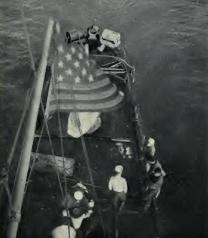
The Flag That Flew
|
|
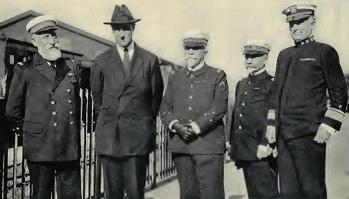
Left
to right – Vice-Admiral Moreau, French Navy,
Assistant Secretary of Navy, Roosevelt,
Vice-Admiral Schwerer, French Navy, Rear-Admiral
Benoit, French Navy, and Vice-Admiral Wilson,
United States Navy, at Brest
|
|
The reports of battery No. 1
mention that on one occasion a six-inch German shell
exploded within twelve feet of the gun, but slight
damage was done, and the matter was officially
dismissed with the remark that the enemy shell
"peppered” the battery. In reply to this "hit" the
battery shortly after dropped a shell into a German
troop cinema creating over one hundred casualties.
Early in October Nos. 3, 4, and 5
took up a position at Thierville, in the Verdun
Sector, and they were later joined in the same
general vicinity by Nos. I and 2, where fire was
maintained on Montmedy, Mengiennes, Benestroff and
Sarrebourg.
On October 27 an enemy shell
exploded in the vicinity of battery No. 5, wounding
five men, one of whom later died of his wounds. Due
to their advanced position which brought them under
constant fire of both the long-range and smaller
caliber guns of the enemy, it is remarkable that the
casualties were relatively few, and especially as
the night firing exposed the men constantly to the
enemy’s observation.
A most valuable service was given
by the batteries, and had the war continued they
were destined for a part which would have been of
the utmost importance. All the materiel withstood
the constant firing effectively and the highest
commendation was received by the officers and men
for their skill in operating the guns.
Mine-sweeping is perhaps one of the
most important and at the same time one of the
dangerous and most disagreeable services rendered by
the naval forces in modern warfare. The experiences
of the little group of United States mine-sweepers
at Lorient was no exception. It will be recalled
that the fleet of United States mine-sweepers in
French waters consisted of nine small vessels which
were originally sent over for patrol service, but
being speedily condemned for this work, due to their
unsuitable construction, were later converted for
minesweeping.
In this department the French Naval
Forces were particularly active, the Tossizza
scissors apparatus, a French invention by which
mines caught by the sweeping gear were released and
allowed to rise to the surface where they might be
destroyed by gunfire, having proved highly
effective. So valuable, in fact, was this
contribution to anti-mine work that it was adopted
by the British Navy for their own extensive
operations.
The United States mine-sweepers
concentrated their operations at Lorient, and there
worked in conjunction with the French in keeping
free the channels and in destroying enemy mine
fields in the vicinity reported by ships or
hydroplanes.
The German mines were laid, by
necessity, entirely by submarines, and only the
constant, untiring, daily sweeping of the channels
could assure the safety of the shipping passing
through them. These mines, of various types as the
war progressed, were in the large part anchored at a
depth of about fifteen feet, on high tide, beneath
the surface, to be exploded by the sides of the
passing vessel which, coming in contact with the
protruding horns detonated the mine.
The French mine-sweepers were built
for this particular duty and were a light-draft type
of vessel capable of proceeding with relative safety
over an existing mine field without striking the
submerged mines. The American sweepers, on the other
hand, were a converted craft and of a draft which
permitted their use for only a couple of hours on
the flood tide. At these times they could pass
safely over the mines, but at lower water there
would have been considerable danger of striking and
detonating the mines encountered. In this work a
number of sweepers worked together advancing over a
supposed field dragging their sweeping gear astern.
As the wire cables which comprised the sweeps caught
on the anchoring cable of a mine, the scissors
either cut loose the mine or the mine was torn loose
from its anchorage and rose to the surface, when it
was promptly exploded by gunfire.
In the earlier years of the war a
type of mine was employed by the German mine layers
which could be "dehorned," and after being thus
rendered innocuous, could be examined. Later,
however, the mines were so constructed that an
attempt to dehorn them resulted in their explosion
and the annihilation of several detachments of
enterprising French sailors.
The hazardous nature of this work,
its monotony and the discomforts of the vessels made
the duties of the mine-sweepers far from enviable
and much credit should be given to the men who
uncomplainingly gave themselves to this branch of
the service.
The value of this service is
indicated by the following letter from the prefet
maritime of the third arrondissement, Vice-Admiral
Aubrey, to the district commander at Lorient.
The C. D. P. L. has recently
informed me how much he appreciates the services of
the United States mine-sweepers in the daily sweep
and the destruction of enemy mines. He has spoken in
particular, of the zeal which these sweepers showed
the second week of July, when in conjunction with
the French, they cleared the mine field Guérande
shoal. This successful operation was carried out in
bad weather under very arduous and dangerous
conditions.
I wish to express to you my sincere
gratitude and will ask that you kindly convey my
thanks and appreciation to the officers and crews of
the Hinton and Cahill and most particularly to the
James, which alone sank four mines.
On a gray afternoon early in
November the sound of cheering greeted the destroyer
Roe as she slid out from her moorings and turned
slowly toward the opening in the breakwater. From
her slender mainmasts a hundred-foot pennant, a
single row of stars in its blue field and two long
stripes of red and white beyond, curved and floated
in the breeze. It was "homeward bound." As the Roe
stood out of the harbor cheers from every vessel
gave her a Godspeed as she passed. From destroyer
decks groups of men with home longing in their eyes
watched her steam on toward the outgoing convoy. A
destroyer signalled "Give our regards to Broadway,"
and "Good Luck, may you follow soon" came back from
the fluttering semaphore on her signal bridge. She
was the first to leave from France, and although the
armistice was declared but a week later, there were
few who watched her departure on that gloomy
afternoon, who dared to hope that the end of actual
hostilities was so near at hand.
A week later the harbor was
glittering in sunshine. It was noon and the crews of
the hundred-odd vessels in the great harbor of Brest
were knocking off their work for dinner. Suddenly
from the shore battery beside the ancient fortress a
puff of white smoke was followed by the dull boom of
a gun; another followed, another, and then another.
The heavy voices of the guns were augmented by a
high-pitched whistle from a great French cruiser,
and an enormous tricolor broke out suddenly against
the blue of the sky. Other guns took up the
challenge; deep-voiced whistles and wailing,
shrieking sirens. The armistice was signed! On every
ship men crowded the decks and cheered madly. Great
flags, the unconquered emblem of America, broke out
on the breeze. The hostilities were ended. It was
over, “Over There."
|
